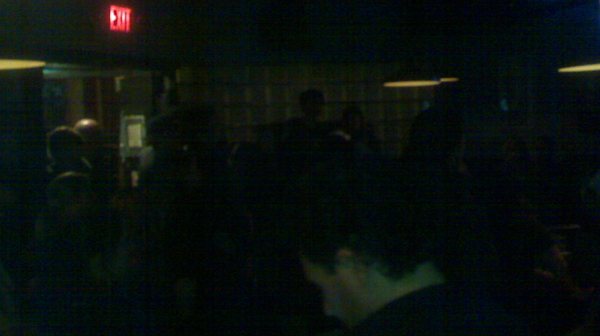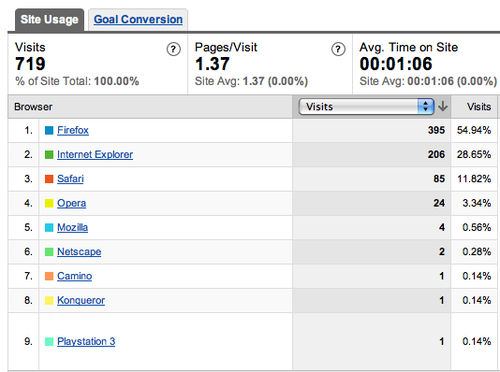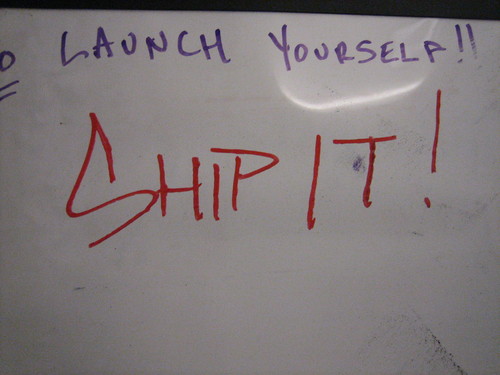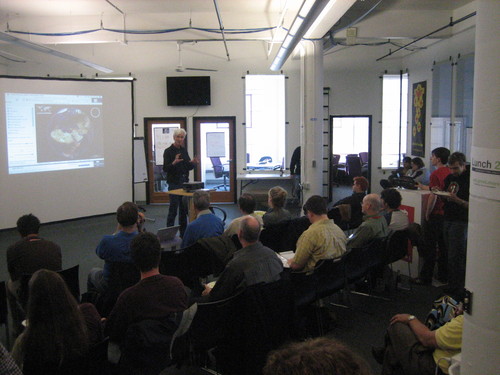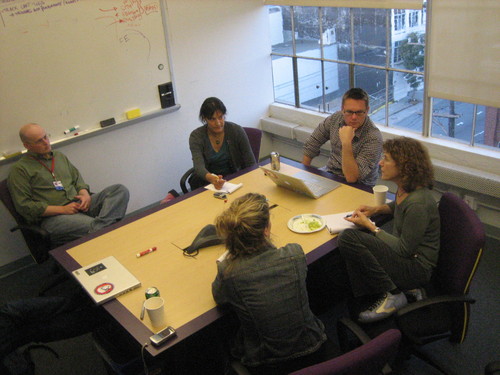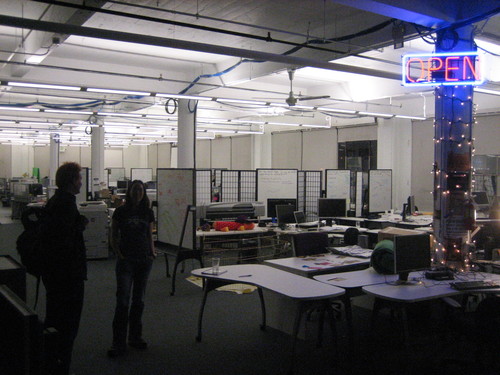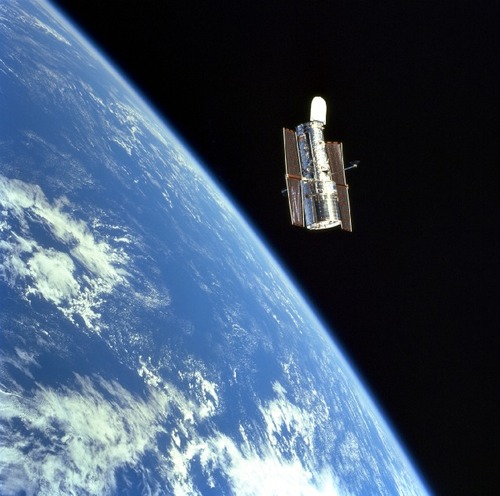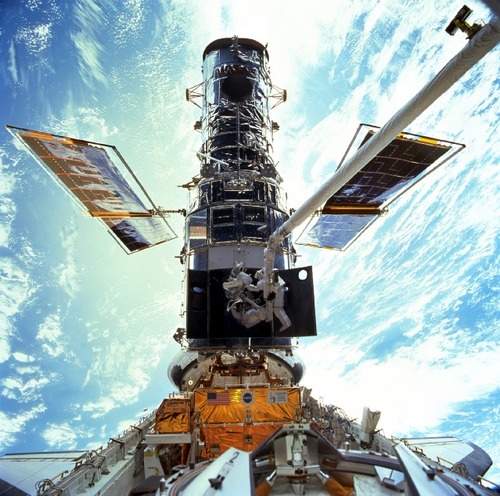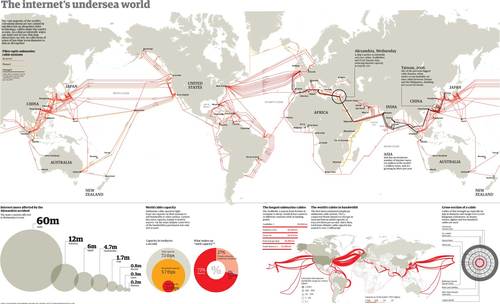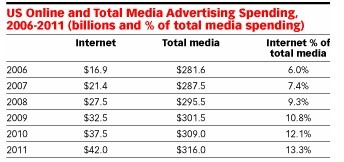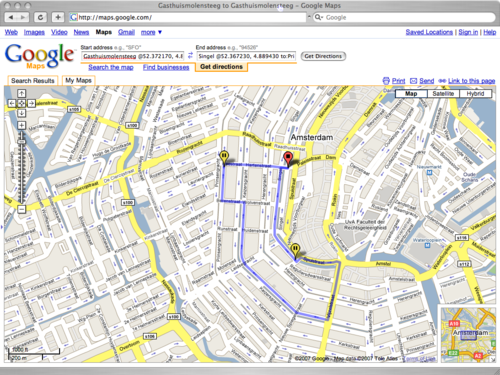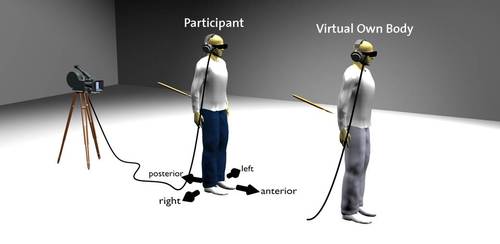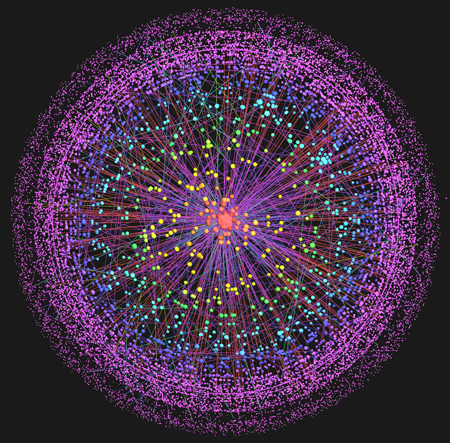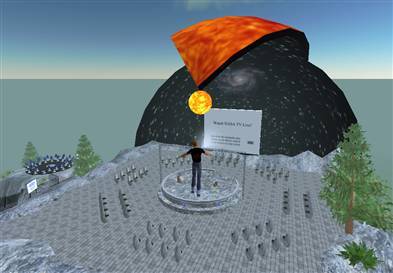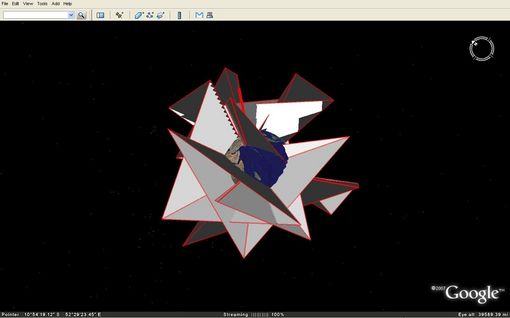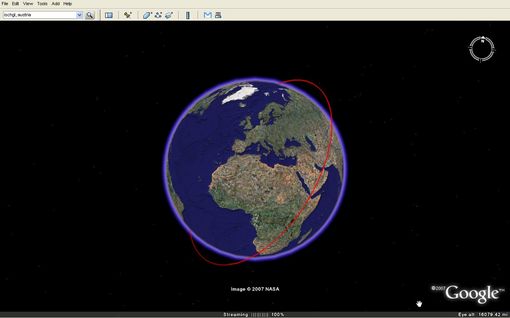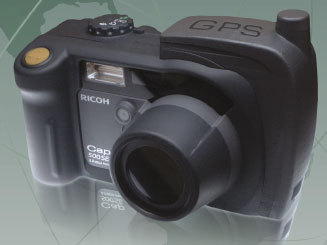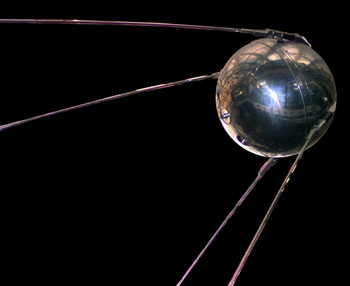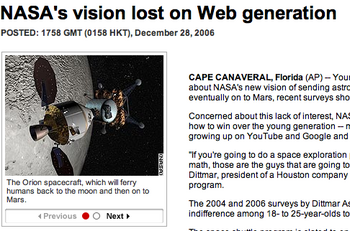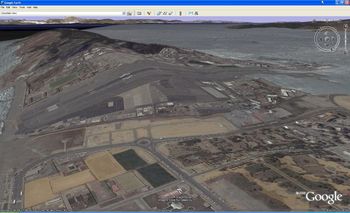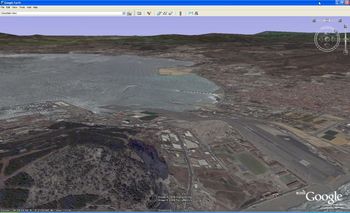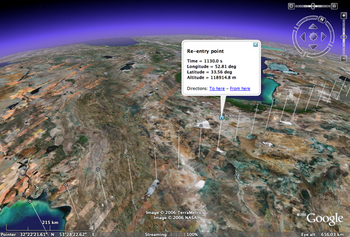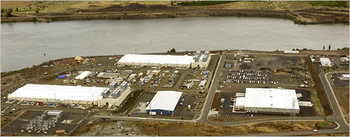This is the Virtual Worlds archive | Back to Main
tobearchived after 6 years
Posted on Monday, September 17, 2012
After exactly 6 years (first post) its time to archive this blog. I've had a great time keeping a trail of my online journeys over these past 6 years and it served me well in my worldly travels, but its time for a new itinerary. I will keep the content up for the Google but I won't be posting here anymore. If you're interested in staying connected, follow me on Twitter @tobedetermined until I find a new home to share my current and future travels.
The medium of the self is the message
Posted on Saturday, May 14, 2011
Good video. Its the same folks that did this experiment back in 2007.
Part I
Part II
(via)
Dinner TV: Where Games and SETI Collide
Posted on Wednesday, November 12, 2008
As a follow up to the previous post, I just found this informal dinner talk between Will Wright and Jill Tarter organised by SEED. Its embedded below, from the looks of it in the code served to you from the servers of Amazon's Web Service...![]()
Nova Spivack Talks about Role of Media in Future Global Brain
Posted on Friday, October 10, 2008
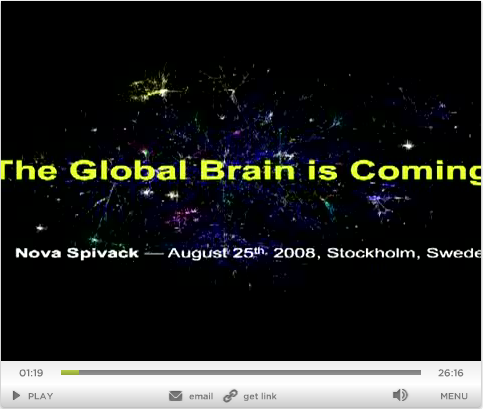
In reference to my previous post, this is what I call an INSPIRING start of a 3-day weekend ;-). Nova basically calls it my favorite talk out of all the talks I have given (more videos from GRID08). I hope whoever gets to decide on where to spend the money for SEC. 407 408 of the NASA Authorization Act 2008 takes the time to listen to his insights:
SEC. 407. PARTICIPATORY EXPLORATION.(a) In General- The Administrator shall develop a technology plan to enable dissemination of information to the public to allow the public to experience missions to the Moon, Mars, or other bodies within our solar system by leveraging advanced exploration technologies. The plan shall identify opportunities to leverage technologies in NASA's Constellation systems that deliver a rich, multi-media experience to the public, and that facilitate participation by the public, the private sector, and international partners. Technologies for collecting high-definition video, 3-dimensional images, and scientific data, along with the means to rapidly deliver this content through extended high bandwidth communications networks shall be considered as part of this plan. It shall include a review of high bandwidth radio and laser communications, high-definition video, stereo imagery, 3-dimensional scene cameras, and Internet routers in space, from orbit, and on the lunar surface. The plan shall also consider secondary cargo capability for technology validation and science mission opportunities. In addition, the plan shall identify opportunities to develop and demonstrate these technologies on the International Space Station and robotic missions to the Moon.
(b) Report- Not later than 270 days after the date of enactment of this Act, the Administrator shall submit the plan to the Committee on Science and Technology of the House of Representatives and the Committee on Commerce, Science, and Transportation of the Senate.
Software, The Final Endless Frontier
Posted on Tuesday, October 7, 2008
From a post by Vint Cerf in the series on Google's 10th anniversary:
A box of washing machine soap will become part of a service as Internet-enabled washing machines are managed by Web-based services that can configure and activate your washing machine. Scientific measurements and experimental results will be blogged and automatically entered into common data archives to facilitate the distribution, sharing and reproduction of experimental results. One might even imagine that scientific instruments could generate their own data blogs.I wonder when small sats finally turn into soap boxes. Vint continues:
These are but a few examples of the way in which the Internet will continue to surround and serve us in the future. The flexibility we have seen in the Internet is a consequence of one simple observation: the Internet is essentially a software artifact. As we have learned in the past several decades, software is an endless frontier. There is no limit to what can be programmed. If we can imagine it, there's a good chance it can be programmed. The Internet of the future will be suffused with software, information, data archives, and populated with devices, appliances, and people who are interacting with and through this rich fabric.Read the whole post here.
10 Bucks Well Spend
Posted on Wednesday, September 24, 2008
Following on from yesterday's syndication of Tim O'Reilly's keynote at the NY Web2.0, I just finished watching the documentary he has been pointing out on several of his keynotes: A Crude Awakening: The Oil Crash. Buy it on itunes from their website and have a peak into the future of post cheap oil society. Quite informative...
Tim O'Reilly's Call to Action
Posted on Tuesday, September 23, 2008
And it ain't throwing sheeps. From last week's Web 2.0 Expo in New York entitled "Web Meets World".
(via)
tobedetermined.org Extended Credo
Posted on Monday, September 1, 2008
Update: A post over at O'Reilly Radar by Nat Torkington reminds me of another quote I've used in the earlier days of this blog. It's a (famous) quote from William Gibson: The future is here, its just not evenly distributed yet. In his post, Nat refers to another quote from Gibson that brings the overarching point home:
One of the things our grandchildren will find quaintest about us is that we distinguish the digital from the real, the virtual from the real. In the future, that will become literally impossible. The distinction between cyberspace and that which isn't cyberspace is going to be unimaginable. When I wrote Neuromancer in 1984, cyberspace already existed for some people, but they didn't spend all their time there. So cyberspace was there, and we were here. Now cyberspace is here for a lot of us, and there has become any state of relative nonconnectivity. There is where they don't have Wi-Fi.
Having a 3-day weekend does have its benefits (like in: having an extra evening behind your computer?). Think I just stumbled upon something like an extended credo for this blog (beyond tobedetermined.org: A blog about outer space, cyberspace, their common future and all that is leading up to it... ). I started gathering some quotes that resonated with me over the years and ended up with this list (read from top to bottom, in that order):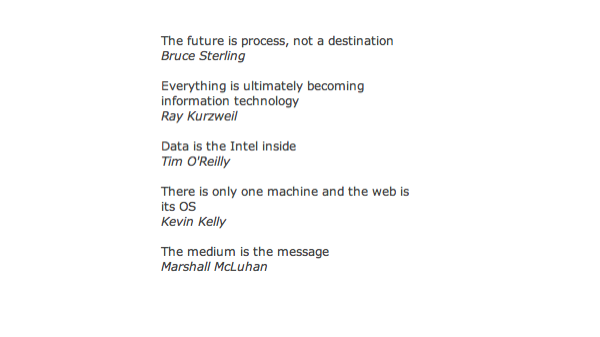
I am sure there are more out there that would fit this list, so if you have any suggestions pls let me know.
Summer 2008
Posted on Friday, August 1, 2008
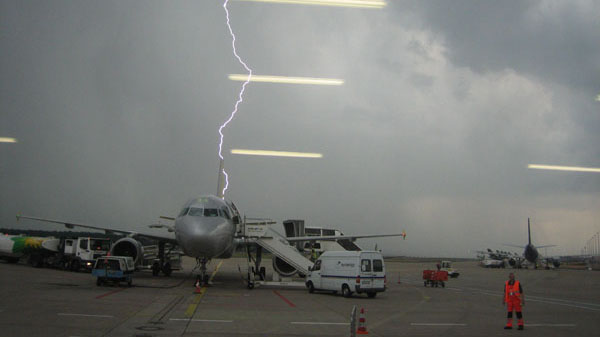
Back from a week of Internetless holiday on the island of Korcula (above photo was at Koln airport just before we were told we could board the plane ;-). Catching up here are a few relevant tidbits:
- The Economist's commentary on NASA's 50th anniversary provides a sharp dissection of NASA's past, present and future. Its the most sensible story on space and NASA I've read in a long while. As always, the comments are worth reading too, if only to see how space proponents bring their arguments into gear to downplay the article's 'hammer on the nail' analysis
- Sanfran article of the week about twitter, relationships, and the bay area working spirit
- Missed OSCON, but here's a 37min intro and Tim Oreilly's comments
- A great discovery: this TED video by kevin kelly. I especially like his McLuhan Reversal analogy. Have to watch it again.
The Stone Age Didn't End Because of a Shortage of Stones
Posted on Sunday, July 20, 2008
Bruce Sterling comments inline on this passionate call by Al Gore for the US to become carbon fuel independent in 10 years.
Time to put some solar panels on my roof here in Palo Alto. Or wait, wasn't I first gonna spend 2 weeks flying around Europe for my holiday, buy the iPhone and upgrade my car (from what I hear SUV's come cheap these days).
Could this be the "Moonrace" of the 21st century?
We need you. And we need you now. We're committed to changing not just light bulbs, but laws. And laws will only change with leadership. On July 16, 1969, the United States of America was finally ready to meet President Kennedy's challenge of landing Americans on the moon. I will never forget standing beside my father a few miles from the launch site, waiting for the giant Saturn 5 rocket to lift Apollo 11 into the sky. I was a young man, 21 years old, who had graduated from college a month before and was enlisting in the United States Army three weeks later.I will never forget the inspiration of those minutes. The power and the vibration of the giant rocket's engines shook my entire body. As I watched the rocket rise, slowly at first and then with great speed, the sound was deafening. We craned our necks to follow its path until we were looking straight up into the air. And then four days later, I watched along with hundreds of millions of others around the world as Neil Armstrong took one small step to the surface of the moon and changed the history of the human race.
We must now lift our nation to reach another goal that will change history. Our entire civilization depends upon us now embarking on a new journey of exploration and discovery. Our success depends on our willingness as a people to undertake this journey and to complete it within 10 years. Once again, we have an opportunity to take a giant leap for humankind.
Yup
Posted on Thursday, July 17, 2008
Wading through +2k unread posts in my list of RSS feeds (Bruce Sterling's Beyond the Beyond).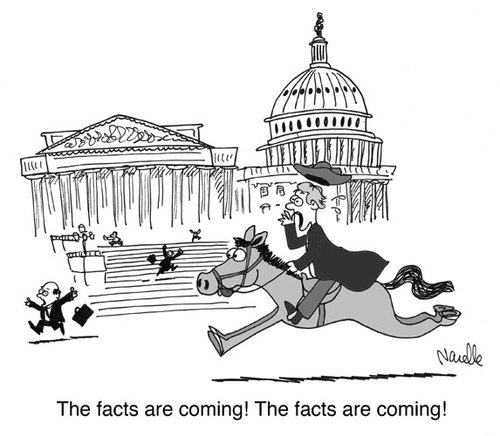
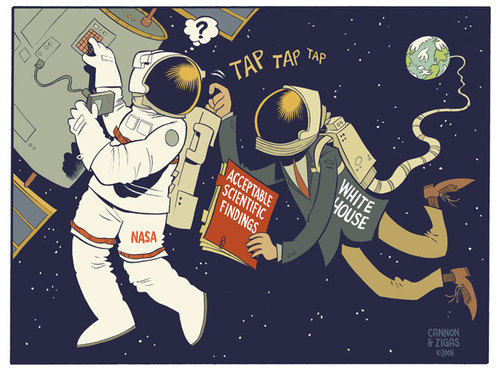
Its You They're After
Posted on Saturday, July 12, 2008
The best analysis on Google's Lively I've read sofar comes from RealityPrime: Its not so much about giving people a nice virtual world to play with, its providing a new interface to harvest new and previously untapped user behaviour. Which reminds me of an excellent article I was send the other day on the near future of advertising, a must-read.
Robots Get Better Every Day
Posted on Wednesday, July 9, 2008
A couple of quotes from an article in the Washington Post entitled 'U.S. Finds It's Getting Crowded Out There' (via):
The cost of manned space exploration, which requires expensive measures to sustain and protect astronauts in the cold emptiness of space, is a particular target."The manned space program served a purpose during the Apollo times, but it just doesn't anymore," says Robert Parks, a University of Maryland physics professor who writes about NASA and space. The reason: "Human beings haven't changed much in 160,000 years," he said, "but robots get better by the day."
Another one:
In its assessment, Futron listed the most significant U.S. space weakness as "limited public interest in space activity."
Hmm, it looks like us humans are a real show stopper when it comes to pushing the borders of reality further into outer space. Perhaps we should consider targeting robots instead of humans with the US civil space PR machine. Once they are on equal par with us, they'll probably be much more enthused and equipped to go into outer space. And after all, our race already had its 15 minutes of fame wouldn't u say? An add campaign targeted at robots...hmm...: "Space, The Final Webservice"
The One Computer
Posted on Friday, June 27, 2008
Kevin Kelly re-iterates his earlier thoughts (a must-read) in the latest edition of Wired (via). Still makes sense to me. And guess who's heading all of this?
24/7 Data Center Breathing
Posted on Sunday, June 22, 2008
From On Clouds, the Sun and the Moon:
Follow the Moon: And with so much focus on energy costs, data center power consumption and cooling (not to mention the environment), there’s also a cloud computing approach known as Follow the Moon. It posits that a cloud provider with physical data centers in several different geographical locations can run the applications that are active from the day side of the world in centers on the night side of the world, taking advantage of lower power and cooling costs.
Space Behind the NASA Portal
Posted on Thursday, June 19, 2008
Ever since the re-design, I've been itching to hit the top right corner of my screen to make all of the modules on the NASA Portal go away, providing me with an unobscured look into outer space (yes, its an OSX thing). One of my current activities involves the NASA Portal so diving into the css sheets I finally got a chance to see what I was looking for. I'd still like to see a realtime background image there some day, but from the first looks into the back end CMS on which the Portal is build, this will have to wait a while ;-)
Real or virtual?
Posted on Wednesday, June 4, 2008
Its hard to tell these days if you look at below photos of todays Kibo docking (via).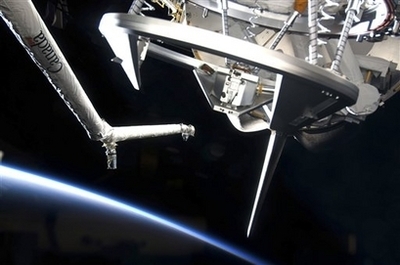
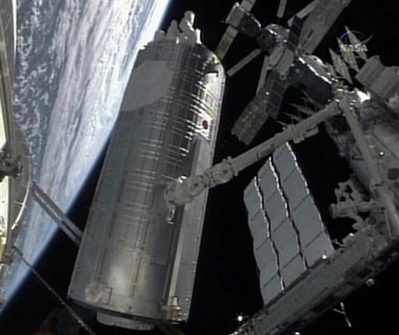
The Awakening
Posted on Tuesday, June 3, 2008
After Phoenix's recent twitter success, satellites are waking up to the opportunity. Its LRO, its LCROSS, its..its...the ISS? The Shuttle? Why not the Shuttle's external tank (it travels a fair bit over land before it gets shot into space), the Deep Space Network antenna's, NASA's Columbia supercomputer ...Hallelujah, let there be light, the sensor web awakens!
(nice job title: for 2 years I was LCROSS twitter. Would like to see some GPS going on at the same time...following all of NASA's hardware around in Google Earth in real time would be kinda neat...)
WorldWind presentation at the Yahoo Brickhouse in SF
Posted on Thursday, May 22, 2008
One of these events which makes me remember why I moved down here from Amsterdam: a presentation on NASA's open source 3d browser at the Yahoo Brickhouse in downtown San Francisco. Great place, great talk, great people. More pictures are at my Flickr. For some reason, I have a hard time finding some more info on the Brickhouse on Yahoo's properties. Weird how they not have a full YBH page up there. Anyway, the video of the talk should become available on the Yahoo Developers Network somewhere next week I was told. I'll update as soon as its up.
World Wide Telescope Released
Posted on Thursday, May 15, 2008
Yep, its here (given the page design you'd mistake it for a Mac site just for a second). Ever since I upgraded to Mac OSX 10.5 (aka Leopard) last week my Parallels XP virtual machine is in a permanent state of reboot so I haven't had a personal interaction with WWT yet, but from the reviews of it over at OgleEarth and The Earth Is Square, it seems to be a pretty nifty application.
Can't wait to get my NASA Macbook Pro exchanged for a proper PC...
The Geoweb Is Evolving
Posted on Wednesday, May 14, 2008
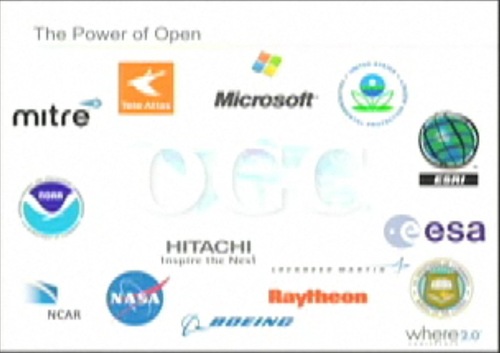
Straight from Burlingame at the Where2.0 conference, John Hanke and Jack Dangermond talk about Google and ESRI working together. Note that there's two space agencies in above image (considering NOAA is not) and a couple of NASA contractors.
Some views to enjoy (until I get back to posting regularly)
Posted on Tuesday, May 6, 2008
Space on your computer
Posted on Wednesday, April 16, 2008
A couple of links from DC Dulles Airport:
- I wrote about a GE vis of the ASAT test earlier last year (earlier post). Following users stats on a little Youtube video I made of the STK ASAT scenario, I come across below AGI's Youtube promo video of the ASAT test.
- If you have a minute, have a look at this simulation environment from DigitalSpace. Once installed (PC only) its pretty neat to push the little rovers around and play with the different gravity options (Earth, Moon, no gravity). There are user interface issues but these will probably be solved along the way.
- GE 4.3 was released yesterday. Some cool stuff: Google gave its Earth an atmosphere, day and night time visualisation and a whole lot more I don't have time to test right now. Check in with GEB for a run down of the new features. But wait, did they alter the shortcuts? I can't zoom in/out using Apple+PageUp/Down anymore.
Cloud computing
Posted on Sunday, March 23, 2008
Nicolas Carr keeps with his story of The Big Switch. This comes from a piece he wrote on the Advertising Age website:
One change that's already obvious is the blurring of the line between software and media. Consumer software, until recently sold like a package good, is becoming the next great media business. The success of a software program is coming to be judged not by unit sales but by the ability of the provider to attract an audience, hold that audience's attention with interesting data and tools, and deliver relevant ads to it.The whole story is well worth the read. Btw, I am not getting paid to include this link or any of the earlier references to that book. Its free publicity. Which all combined seems to help to get him into the WSJ bestsellers list. He must have touched a nerve in IT land.
Richard Dawkins @ UC Berkeley
Posted on Friday, March 21, 2008
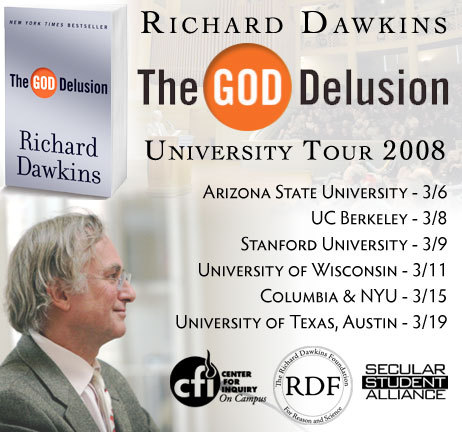
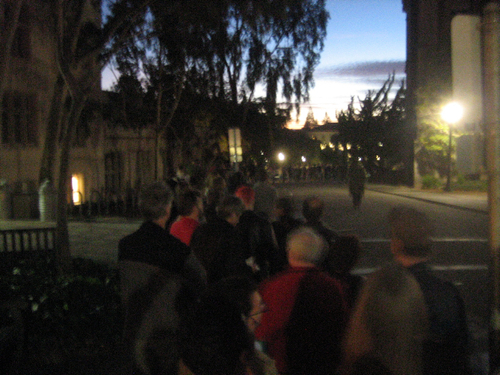
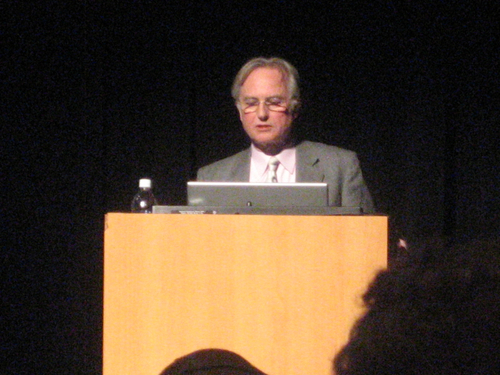
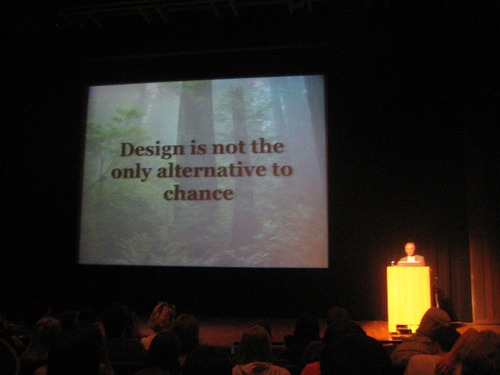
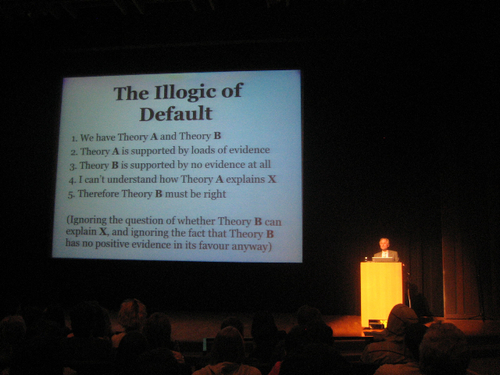
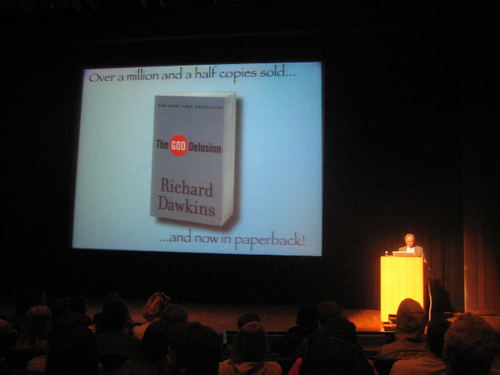
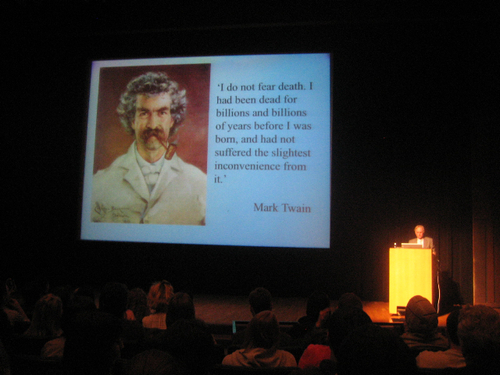
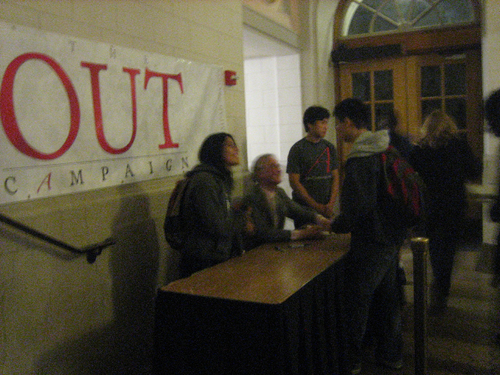
There goes another one from my wishlist. 2 weeks ago I went to see a lecture by Richard Dawkins in the Wheeler Auditorium at UC Berkeley. Although the God Delusion is not my cup of tea (I don't have a religion to loose), my admiration of him comes mainly from his evolutionary work like the Selfish Gene and others. Arriving that saturday evening, things were looking a bit grim at first, I was expecting not a big turn out, but when I arrived there was a large crowd and a long row. Good to see he has a big following in the US. With a bit of luck I managed to get into the auditorium on a standby ticket.
Next on my list: the computer history museum, lunch at Apple and Google HQ, and a couple of others. Keep you posted. Oh, and another one, the Columbia supercomputer at NASA Ames (image below), been there as well wednesday, thanks Creon.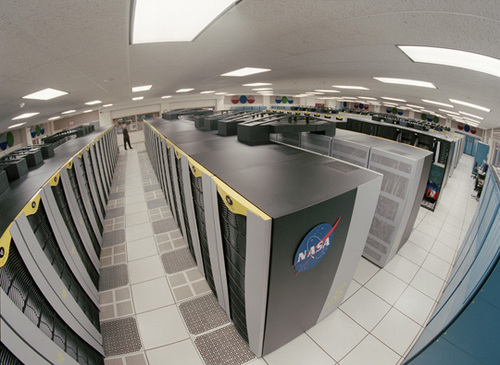
A.C. Clarke died today
Posted on Wednesday, March 19, 2008
...(bbc news)
update: Google's Chief Evangelist Vint Cerf also says goodbye to Clarke in this post. It includes a nice video of Clarke recorded end of last year.
A story of planets and links
Posted on Wednesday, March 12, 2008
Time to get on the bus
Posted on Wednesday, February 27, 2008

Ok, so its time to give a brief update on my (physical) whereabouts. Since last thursday I moved from Amsterdam to Mountain View, Silicon Valley to work with Chris Kemp and his collegues over at NASA Ames starting next monday March 3rd. Weehoo! Finally, a long held dream is coming true, taking part in the upcoming merger of outer space and cyberspace, right at the heart of where all things space are happening. Couldn't be better!
As for this blog, looks like I will be using it from now on to give you a personal insight in my personal and professional experiences here in the Valley. Sofar, these include a great arrival and first few days enjoying the Bay Area rainy season (yes, it can rain here...), a visit to the Vertical Motion Simulator on NASA Ames premises last friday (for photos have a look at this flickr album), my first NASA vrimibo with Ames director Pete Worden, Chris Kemp and several of my upcoming collegues (vrimibo is short for 'vrijdag middag borrel', Dutch for the traditional friday afternoon drink), a first counter-clockwise drive around the Bay Area, and writing off the first item on my wishlist of things-to-do-when-I-get-to-the-Bay-Area: attending a Long Now seminar in San Francisco (on which more in a follow-up post).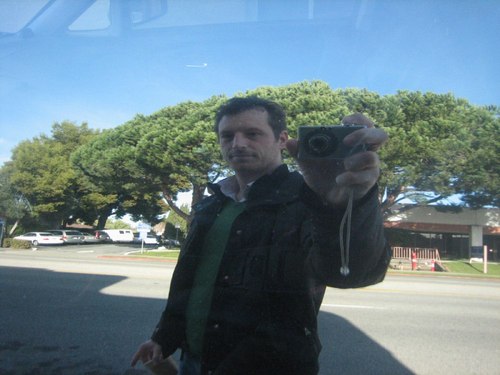
Immersive Video
Posted on Sunday, February 10, 2008
Via OgleEarth, 360 degrees immersive video delivered to you through the Internet. Impressive. And shareable, like the ones here below (hint: drag the arrow inside the videoscreen).
The Medium is the Mind
Posted on Saturday, January 19, 2008
Another good reason why to read below book, the following quote comes from the author's blog:
"The medium is the mind," I write toward the end of The Big Switch, arguing, as others have before, that the tools we use to gather, store, and analyze information inevitably exert a strong influence over the way we think. As the internet becomes our universal medium - what the director of the Annenberg Center for the Digital Future terms "a comprehensive tool that Americans are using to touch the world" - its technical characteristics also begin to shape, slowly but inexorably, the workings of our memory and our other cognitive processes.
A good way to spent a couple of days with the flu
Posted on Thursday, January 17, 2008
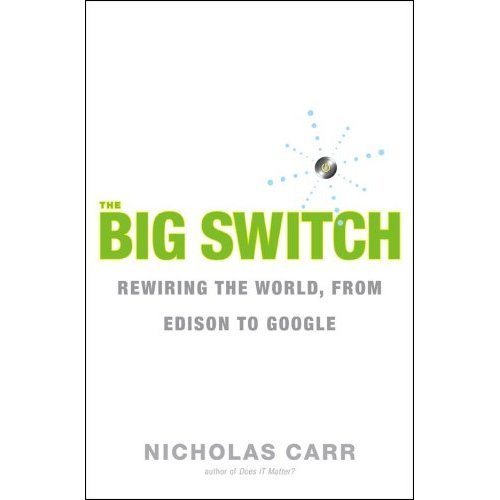
Read The Big Switch. Really, you won't regret it. Gave me the same inspiration as reading The Google Story a couple of years ago. What the future of the Internet has in store for us...
There goes another space based solution
Posted on Thursday, January 17, 2008
Just watching the keynote by SJ. As could be expected, there turns out to be a good reason why the iPhone doesn't carry a GPS receiver. There is a terrestrial way to get your position with less battery expenditure. Its Skyhook Wireless, they even call it WPS (Wi-Fi Positioning System). Combined with Google's triangulation of cellular network antenna's, the positioning is apparently considered to be accurate enough. There goes the market for Galileo. Reminds me of Iridium and the promises of cell phones by satellite, which was totally swepted away due to the proliferation of terrestrial networks.
Welcome aboard
Posted on Sunday, December 23, 2007
Tugunska Asteroid Simulation
Posted on Saturday, December 22, 2007

Where 50 years of atomic bomb simulations pays off. Beautiful! Check out these videos at Sandia Labs.
DinnerTV: Galileo
Posted on Monday, December 10, 2007
Belgeoblog links to an informative Belgian documentary about the Galileo project and its political and technological challenges. In a mix of Dutch, French, English and US English spoken languages and brought to you in 24 style. Well worth to watch!
NASA OS
Posted on Monday, December 3, 2007
NASA launched its re-designed portal NASA.gov over the weekend (more at NYT and Wired). First thought: Wow! Great to see a space agency portal evolve into an open platform for space. Second thought: Leopard's Time Machine. Haven't installed the recent OSX update myself yet but at first glance the background of the new NASA portal seems to have a lot in common with that of Time Machine ;-) (earlier post). I'm currently reading Marshall McLuhan's Understanding Media - The Extensions of Man which, thinking of the Extensions of Man out there (aka technology, aka satellites), applies nicely to my Macbook. I guess in the not too distant future we'll be able to pick our favorite live satellite stream as the background to the NASA portal (like this one from SOHO). Too bad exposé doesn't work on the NASA portal because I find myself hitting the top right corner of my screen every time I want to have a look at the background. Some NASAwatch reader comments on the redesign are here.
Another inspiring release came out this week from NASA: the proceedings of the Participatory Exploration Summit held earlier this year @ Ames.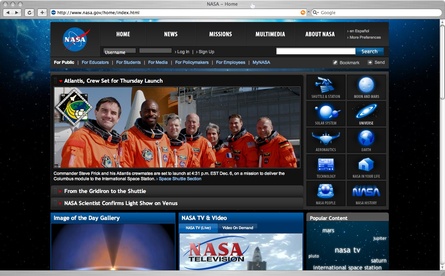
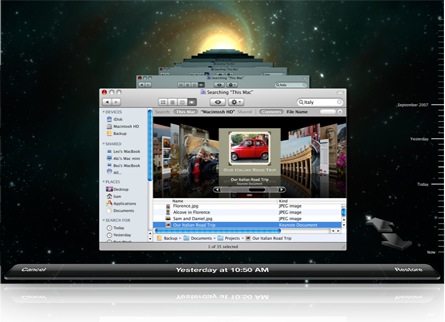
Google Earth and the Evolution of the User Interface to the Internet as platform
Posted on Wednesday, November 28, 2007
After wondering about GE's evolution myself yesterday, Techcrunch is now running a somewhat more blunt story of Google Earth heading towards extinction question mark:
Google has announced two new features for Google Maps that mimic features in Google Earth, begging the question: is Google Earth on borrowed time?The first new feature is the additional of terrain in Google Maps. The terrain fly over feature has long been available in Google Earth, but now you can fly over a map and see the contours of the land, all without the need to download Google Earth.
The second new feature mimics the community contribution feature of Google Earth. “Our Maps” brings wiki-style collaboration to Google Maps, with users able to annotate places and share those notes with friends or the greater public.
Google acquired Keyhole in October 2004 and it was immediately obvious as to why: Google wanted the satellite imagery to support their move into serious mapping. Keyhole provided Google Earth, a downloadable program that gave a then unprecedented view of the earth through the use of satellite imagery, but Google isn’t a software company, Picasa and a few small efforts aside. Google has integrated many of the functions from Keyhole into Google Maps whilst continuing to sustain Google Earth, but for how much longer? As Google Maps takes on more and more of the functionality of Google Earth the appeal of Earth must diminish. It also makes sense that Google would rather grow and sustain a web product over a software download. Google Earth will still be with us for some time to come, but how long is now up to Google, and I’m betting that Google is already looking at ending support sometime in the next year or two as Google Maps becomes everything Google Earth now is, but online and without the download.
Looks like Avi has the most sensible comment in there which deals with the topic at hand:
...As CPUs and browsers become more powerful, the features of the two applications will merge, as I’m sure was the plan all along.But since browser evolution has been so excruciatingly slow, I think it’s far more likely that we’ll see Google Earth become the defacto 3D web browser vs. Duncan’s prognostication.
Google Space Agency
Posted on Monday, November 26, 2007
A quick backlog of links related to the Google NASA coop. They're working on it down at Ames in what is called the 'Planetary Content Team' (nice title):
The Planetary Content Team at NASA's Ames Research Center develops software that makes it easier for scientists and engineers to publish and access Earth and planetary imagery and data via the Internet. This includes both educational/outreach content aimed at the general public as well as technical data aimed at the scientific community. Headquartered in the Intelligent Systems Division at Ames, the team also includes partners in other areas of the agency and elsewhere.
They do both the NASA Google Moon work (Google maps only sofar but they're working on a Google
“NASA’s objective is for Google Moon to become a more accurate and useful lunar mapping platform that will be a foundation for future Web-based moon applications, much like the many applications that have been built on top of Google Maps,” said Chris C. Kemp, director of strategic business development at NASA Ames. “This will make it easier for scientists everywhere to make lunar data more available and accessible.”That's gonna come in handy when the robots are going to land on the Moon in the decades to come.
View Larger Map
Remap our intuition
Posted on Monday, November 26, 2007
A new video with Will Wright talking about Spore at TED earlier this year. Great stuff. Some interesting quotes and discussion @ 12:10 -> "remap our intuition" - "computer simulations can recalibrate your instinct across vast scales of both space and time" - "better calibration on long term thinking".
Digistuff
Posted on Monday, November 26, 2007
Alexander van Elsas points to a flickr set with some nice quotes. They're not all that great but enough are interesting to wade through. Here are a few of my favorites.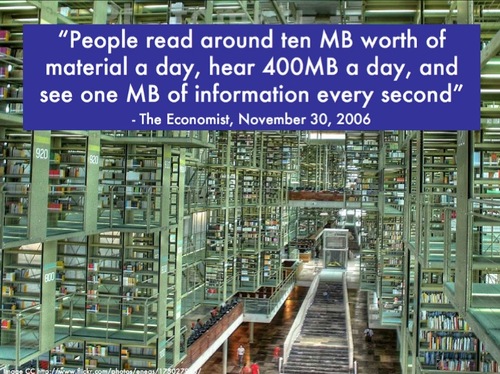
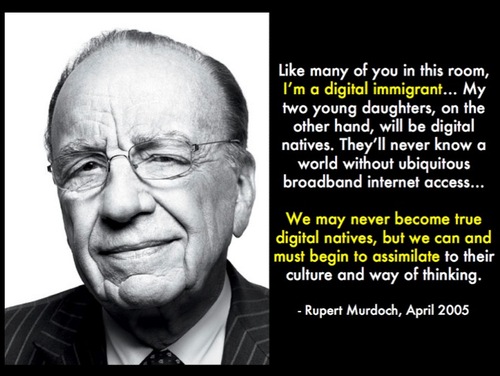
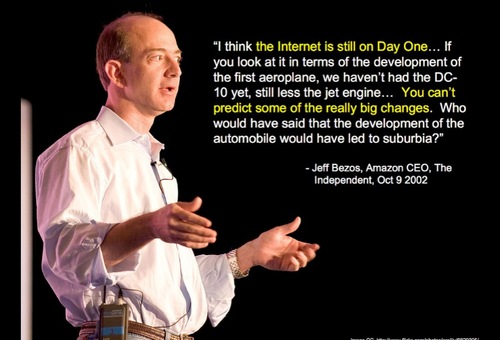
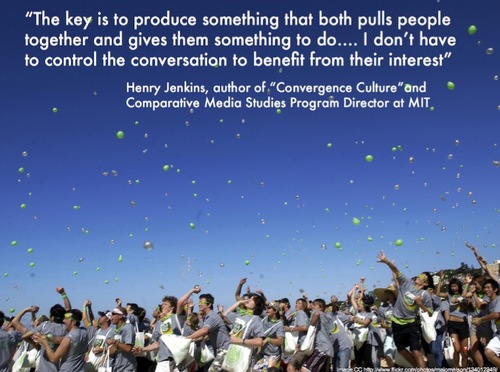
Some thoughts following the Space Explo Conference
Posted on Tuesday, November 13, 2007
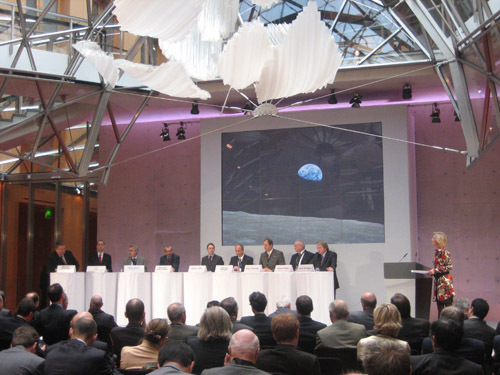
Update 15 November: I was told at ESTEC today that videos of the conference will indeed be posted lateron once they are finished with the editing.
I went down to Berlin last week to attend an ESA/DLR conference on the future of Space Explo in Europe. A lot was said, presentations were abundant, and the various stakeholders (in particular politicians, space agencies and industry) gave their view on what Europe should be doing in the years to come on space explo. One of the main outcomes of the conference: the European Space Exploration Strategy has been reworded to the European Space Exploration Programme...he, these things can make a world of difference.
Interestingly enough, the M word, as in Moon, is still hard to pronounce by Mr. Sacotte of ESA as the agency has decided it should focus on the Mars. Seems this is a position they took when NASA was fully engaged with Mars exploration back in the early 00's. However, since then, Bush has redirected the NASA strategy towards bringing humans back to the Moon, and it seems hard for ESA to bring its strategy in line with this redirected global explo agenda. So while all countries pulling any weight in the space explo arena, China, India, the US of A, all have their focus on the Moon, Europe seems to be struggling with their lock-in in thinking about the Mars (the English pronounceation of native German speakers brings some funny mashups, as in talking about the Moon vs talking about the Mars). Germany however isn't fooled and recently announced its plans to develop a national lunar probe, something that was re-iterated at the conference by DLR Director of Space Programmes Mr. Dollinger.
There was a point where I got intruiged about the way they talked about the usual dichotomy between robotic (unmanned) and human exploration. Usually, this debate quickly ends in the trenches where the proponent on either side digs him/herself in with the usual arguments, leading nowhere. A first smart remark in this context I remember from US astronaut Jeffry Hoffman (of Hubble repair fame) who made the comment at ISU about the complementariness of humans and robots (I don't remember his complete argument, but given that he went up to space to repair a robotic explorer kind of paints the picture of his understanding). At this conference, there was the same question on the table. On itself an interesting question and space is one of the few places where this comes up all the time due to the shear costs involved in sending humans up. This time, it felt as if the conference participants, all human to my knowledge, where there to make a strong case for human exploration...because all of us attending were human. It seemed there was a stance in the robotic/human debate about us against them. Its the first time I interpreteted the debate this way, but it makes for an interesting perspective on where things might be going. The drive to explore doesn't change, its the means that are under scrutiny. Another argument in this context, one that I made together with an ISU collegue last year at a presentation was the following: the most efficient space suit is one without a human inside.
Another important topic which seemed to come up every 5 minutes during the conference was the need for communication of why Europe needs to take part in this global exploration agenda. Well, I guess its true then. The 'Artist as Space Explorer' space & the arts exhibition was nice in that respect but I had a strong deja vu of some 7 years ago when I was involved in a similar type of set up for ESA and the exhibition was mainly used as decoration around the bar with free champagne. Not that different here. Still, it appears there is a little seed taking root at ESA. Hope they'll let it grow...
If this were the web2.0 Summit held in San Francisco last month, the presentation videos would have been online by now. But this is a meeting of much less importance so no videos yet (space exploration...wasn't that something with Apollo?). I really hope they put some videos of the conference online, but given ESA's track record of keeping the walls high and dry, I have my doubts. I'll certainly address it when I get to ESTEC this week. Also in terms of putting the presentations online. If you're interested to put some faces to names, have a look at the flickr photoset I uploaded with the main talking heads. Below pictures were from a presentation by astrophysicist Hans-Joachim Blome about the Cultural Dimension of Human Spaceflight and Exploration. He managed to stay out of the usual paths and gave a glimpse at exploration from a scientific evolutionary point of view. I hope to receive his presentation later this week so I can post it here. 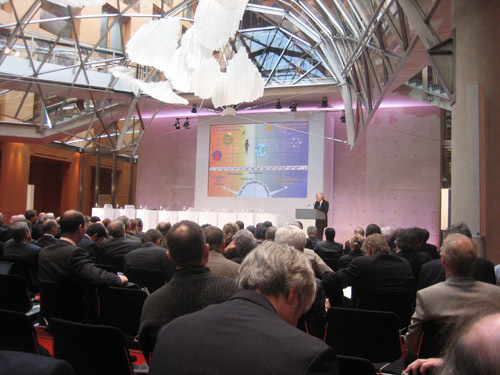
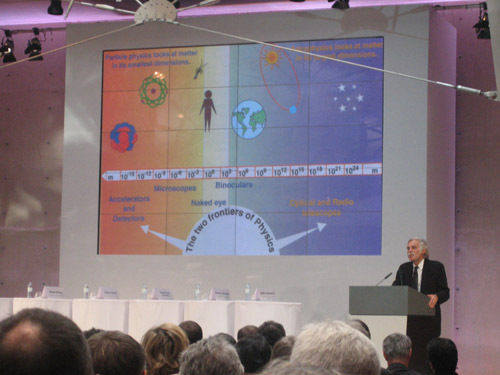
Targeted advertising...or machine learning...?
Posted on Tuesday, November 6, 2007
Which of the two was it again? Who's teaching who? This insightful article Can Facebook feed its ad brains? on the imminent Facebook ad platform (and related industry) gives some clues. It still amazes me that this is the business model on which most of today's web2.0-ish Internet ventures thrive. Highly relevant advertising. Actually, when I think of it, the 'what other users liked who bought this book' feature over at Amazon is quite ok. Not that I immediately go out and buy all those books, but it provides a bit of context, and in that sense its not all that unuseful. These emerging data patterns still strike me as the Internet's equivalent to thoughts emerging, although I also immediately hear myself saying: "don't metaphor me in".
I had a very brief chat on Skype late last night with a friend over in Australia who was just about to go to work in the morning and who had this to say about it:
the 'machine' is the mechanism: the mechanism is the people. The 'machine taking over' is ultimatley a submission unto the hive of the people - it is a social demise as well as the literal manifestation of technology - and an avoidance of the self, the self will and self power of thought
DinnerTV: Its getting there, the Social API
Posted on Saturday, November 3, 2007
Aka OpenSocial. Below video gives a good intro.
DinnerTV: Web2.0 Summit videos
Posted on Friday, October 26, 2007
Another good one, Google, Microsoft and TeleAtlas talking about one of the web's edges, i.e. mapping. Btw, if you experience some problems with scrolling through the videos (which is not allowed!?), you can also subscribe to the videos via iTunes and scroll through them that way.
Vint Cerf on the Status of the Interplanetary Internet
Posted on Sunday, October 21, 2007
Found at SpaceDaily:
Internet preparing to go into outer space (nice title!)
After expanding across Earth, the Internet is now set to spread into outer space to reach parts no network has gone before, one of its co-creators predicted Wednesday.
Vinton Cerf said the proposed "interplanetary" Internet would allow people an ability "to access information and to control experiments taking place far away" from Earth.Expanding into the solar system would bring new rules and regulations too, he told an annual Seoul forum, saying he and other experts were working on a set of standards designed to guide space-era Internet communications.
"Finally, the Internet can take us where no network has gone before," said Cerf, who is Google's vice president and chief internet evangelist,
He said he and a team of engineers at the California-based Jet Propulsion Laboratory would complete a key part of the project -- establishing standards for space communications like those for Internet -- in three years.
Cerf told a separate news conference that new standards were needed because of the huge distances and time delays involved in communication across space.
He went on: "This effort is now bearing fruit and is on track to be space qualified and standardized in the 2010 time frame.
"Eventually we will accumulate an interplanetary backbone to assist robotic and manned missions with robust communication."
Geofencing
Posted on Tuesday, October 16, 2007
Doing a quick internet scan on GPS enabled devices, I run into an interesting term: Geofencing (e.g. here). Makes me think of draggin' a route on Google Maps.
Virtual just another layer on top of physical
Posted on Friday, October 12, 2007
Tim has an interesting post up at O'Reilly Radar where he talks about the announcement of IBM and Linden Labs (creator of Second Life) that they're working together on interoperability of virtual worlds:
I look also for the 3D web to interoperate with location-based services. We shouldn't think of this interoperability as being just for virtual worlds. Ultimately, virtual is just another layer on top of physical. GIS folks don't think of maps per se, they think of map layers -- hundreds or thousands of levels of data overlaid on the world. Many of these layers are abstract and virtual. Aren't street addresses actually virtual? Might not other classes of data be anchored to the real world in some way? A company has a physical address, but they also have an address on the telephone network, an address on the web, and many others. Just as a skyscraper reaches into the sky from a single street address, housing thousands of souls at work or at sleep, might there not be virtual towers anchored to physical locations, embracing and extending our world?
There's quite a future ahead of us here. It's silly to try to recreate the wheel (or to own the wagon) when by working together we can build something that is so much bigger. Open standards are a winning strategy.
DinnerTV: Facebook meme
Posted on Monday, October 8, 2007
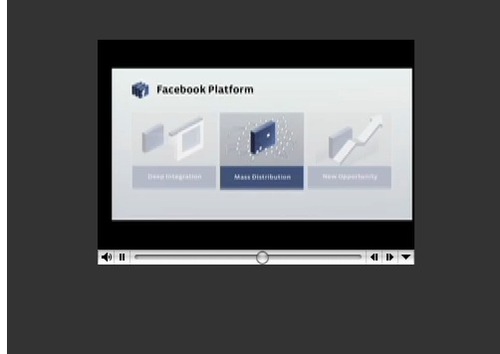
A few weeks of relative unplugged quality time and whoop, you're missing the 'next big thing' on the Internet. It took a while, but I finally spent some time reading up on the Facebook meme. Mmm, interesting, a pagerank Social Graph view on people instead of websites...For a good intro, read this, make an account here, and have a look at this video with Mark Zuckerberg talking about the Facebook platform for developers (not sure if I like his version of the Steve Jobs style though...).
Finally: a peak inside online mapviewing behaviour
Posted on Thursday, September 27, 2007
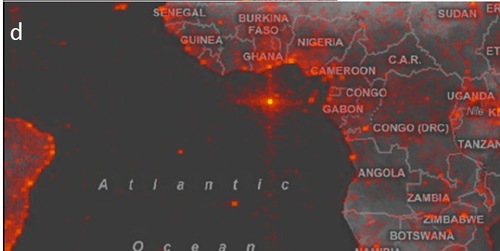
What are we looking at in online interactive mapping systems such as Microsoft's Live Search or Google Earth/Maps? Interesting stuff to wonder about. All Points Blog thinks so too and links to a paper by Microsoft researcher Danyel Fisher entitled Hotmap, Looking at Geographic Attention (above image shows one of many intruiging images from the paper, this one depicting a bright spot at Latitude/Longitude (0,0)).
Evolutionary benefit from Space Explo
Posted on Thursday, September 20, 2007
Reading up on the Google Lunar X Prize at the BBC I come across this quote from Peter Diamandis, X Prize founder (and ISU founder):
"We are confident that teams from around the world will help develop new robotic and virtual presence technology, which will dramatically reduce the cost of space exploration," said Dr Peter Diamandis, chairman of the X-Prize Foundation in a statement.Working in the space business, one question that keeps me busy these days is trying to understand which of the technologies to be developed for the "space race to come" will influence society on the long run. Computer chips have gained evolutionary benefit from both the military (nuclear missile guidance systems) and the '60 space race (Apollo descent stage). If history accounts for anything, it is pretty clear spin offs from endeavours such as space exploration will play out in society in unexpected ways. With the X-prize's emphasis on robotic exploration and telepresence technologies, I bet you there will be more of this fusing into society in the decades ahead, the question is only how exactly. By the time space exploration gets anywhere, I doubt we will experience the world as we do today.
Powers of Ten: still your best guide on what's coming
Posted on Tuesday, September 18, 2007
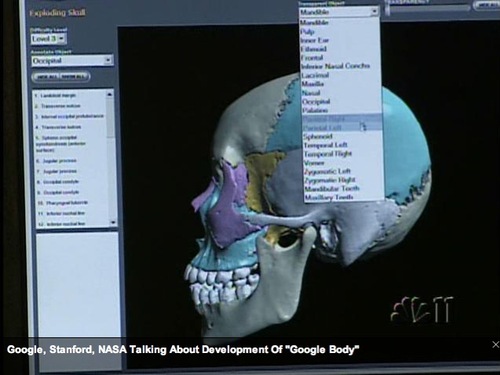
With Google Sky just released, the news of an upcoming Google Body (slideshow) makes me tempted to make a graph with all Powers of Ten from the 1977 movie and see at what level scientific research, government research agenda's and corporate interests are playing out (and not to forget: the military agenda!). Seems this Powers of Ten paradigm (often quoted as inspiration for Google Earth) is still your best bet at trying to understand and predict human progress these days, not only in terms of research but also in terms of accessibility of these non-human scales to average citizens through tools such as Google Earth.
This weekend I had another brief encounter with Google Sky after my initial confusion a few weeks ago from lack of reference while scrolling the skies. This time it was a lot better, although I still think an actual 3D representation, at least of the Solar System, would be way cooler than the MyFirstPlanets representations currently moving around Google's heaven (have you seen the demo tour in Celestia yet?). The current sky implementation feels more like a representation of how old civilisations once thought stars were holes in the black heaven sphere with fire behind it making them shine like they do. Its a good beginning, but they definitely need to catch up with 21st century cosmology.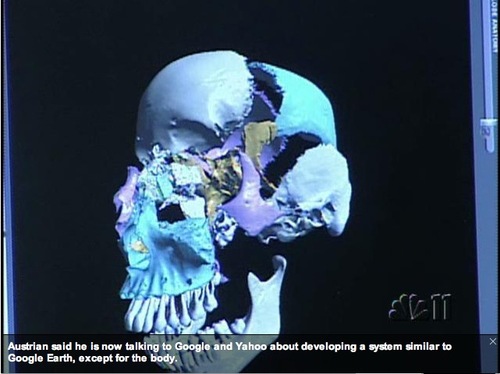
Google + X PRIZE = Lunar X PRIZE + Google Moon
Posted on Thursday, September 13, 2007
Update: more at Wired & CNN.
Just in: Google Sponsors Lunar X PRIZE to Create a Space Race for a New Generation. More at googlelunarxprize.org. At the same time, Google's LatLon blog announces an update to their version of Google Moon, an outcome of the collaboration between Google and NASA Ames.
DinnerTV: South Park meets World of Warcraft
Posted on Thursday, September 13, 2007
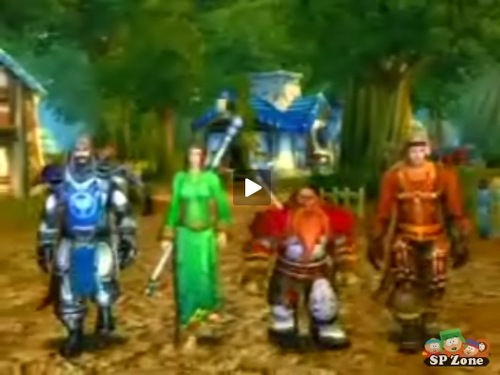
I just read that one of the best pieces of television in a looooooooooong time has just won an Emmy (in Dutch). I've watched it over and over again, and for once this episode remains funny even after seeing it more than 10 times. Strangely enough, I've never found a good version on the Internet to share with you...until now. If you can handle the somewhat lower resolution and the annoying logos flying in and out of the screen in this 'official' online version (is YouTube going to be like this? I hope not!) then enjoy: South Park meets World of Warcraft (be sure to check the full screen button).
Geoweb In The News
Posted on Sunday, September 9, 2007
'The world on Your Desktop' in The Economist, a fair read (with a good introduction over at OgleEarth) plus a first commentary on the article at TechConsumer (both via OgleEarth).
Google Earth and Google Sky Currently Don't Connect
Posted on Friday, August 31, 2007
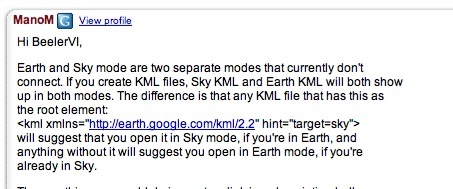
Currently..? Above screendump shows a response by Googler ManoM on the KML Developer pages which caught my eye while doing my weekly checkup on new discussions and topics. Still no time to do a proper scope of all the new stuff that came out with kml2.2 and Google Earth 4.2 but this provides an interesting lead when I'll find that time.
Art2.0?
Posted on Sunday, August 26, 2007

Nice how the EPFL lab below uses above image of Magritte for their lab (aptly named 'pic home.bmp').
NASA2.0 & OBE
Posted on Saturday, August 25, 2007
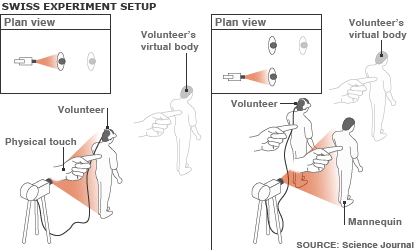
Another good move by NASA: NASA partners with Internet Archive to put space archives online. More over at CNET NEWS. Meanwhile, in Lausanne, a team of researchers recreated an Out-of-Body Experience in the lab...sweet.
Google Turns To The Sky
Posted on Thursday, August 23, 2007
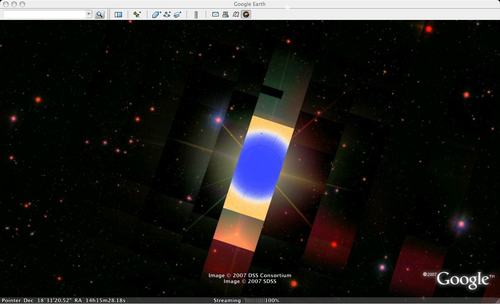
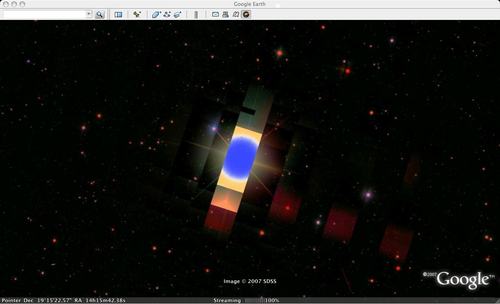
If you haven't heard about Google Sky yet, well, than you're not reading Google LatLon, Google Research blog, the Official Google Blog (that's a lot of Googleblogs...), Google Earth Blog, OgleEarth, BBC NEWS and all the rest of the Blogosphere which has found their way to Google Sky. I'm a bit short on time so I'll just let the others do the first scoop of its features. I plan to come back with some personal insights when I find a chance to spent a good few hours with it. Diving in for the first time, above views I found quite intruiging as a universe kind of equivalent to the patchy Earth that is Google's Earth.
User Generated Content Generator, aka a human being
Posted on Monday, August 13, 2007
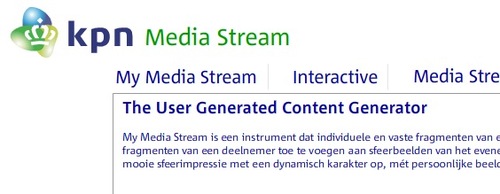
Talking to a friend here in Amsterdam who is in the online video business (MyVidayo), he points me to a website with the term 'User Generated Content Generator' (click My Media Stream)...what is that all about? Recursion? Abstraction? Web3.0? Agents? Meanwhile, Tim O'Reilly posts an insightful list of quotes.
NASA and Microsoft: Photosynth Exploration
Posted on Monday, August 6, 2007
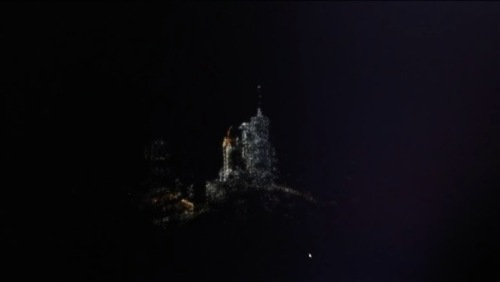
Just in (and spreading on the Internet like a wildfire, like here, here, here and even here): NASA & Microsoft collaborate by making available a Photosynth environment of the Shuttle launch pad at the Cape. Beautiful job!! (its only viewable on XP SP2 or Vista, but for Mac users there is at least a video to see what they are missing ;)
I remember posting a remark on the Photosynth website once suggesting they'd make a Photosynth environment of all Earth photos taken from space, but I wonder whether that is actually feasible given de lack of depth of these images and the changing weather patterns.
Btw, in case you're interested, here's a 58min GoogleVideo going into some of the details of a tool like Photosynth, except this one is not Photosynth but Photosketch (via).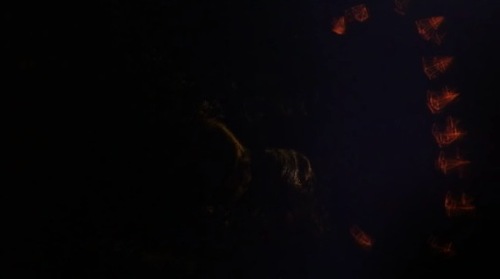
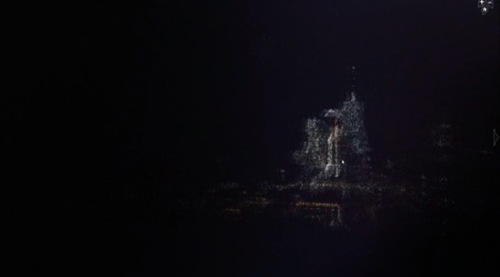
DinnerTV: Vint Cerf on the architecture of the coming Geoweb
Posted on Monday, August 6, 2007
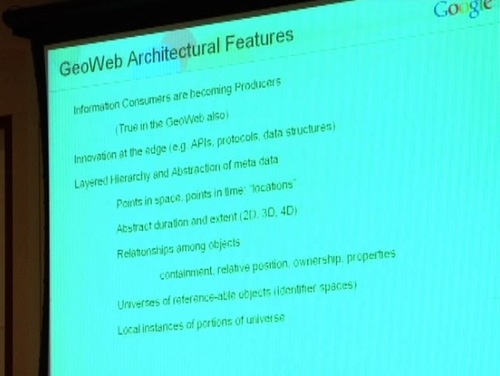
Thought provoking videos have come from the Geoweb2007 conference in Vancouver end of July (via). My shortlist:
Vint Cerf (a must-see)
Jack Dangermond (fresh view for me)
Michael Jones (always interesting)
I was especially struck by the conceptual insights of Vint Cerf where it comes to the architectural design of something as intangible as the virtual Geoweb. And of course his opening remarks to keep the Geoweb conceptually open for the eventual SolarSystemweb are music to my ears ;) Quote of the day comes from Michael Jones:
A map has become a searchable information landscape
Data as architecture?
Posted on Saturday, July 28, 2007
Seeing these great images (and these) at DigitalUrban (like the one here below), I find myself thinking the same thing as their post title (Data as architecture) while looking at below image of DELL's website visit statistics in Google Earth (via Google Blog).
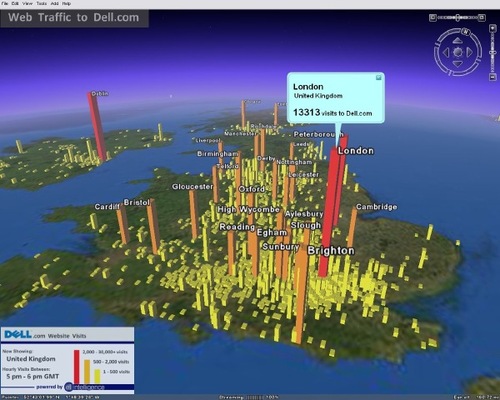
RoadmapHuman
Posted on Saturday, July 28, 2007
From AllPointsBlog comes the following quote:
The biggest threat facing the two competitors [NAVTEQ and Tele Atlas] in the future may be user-generated map content – a mapping equivalent of YouTube, as it were.
Following on below post, and reading these two articles in Newsweek and SignonSanDiego about how TeleAtlas and Navteq go about their business, I can't help but metaphor you in by comparing their on-the-road employees with the likes of GoogleBot, Technorati Searchbot, Tailrank Robot etc. Isn't it funny how we start mimicking behaviour from the virtual world into the real world. I wonder what other behaviour we might see emerging in the real world which has its origin online?
Twitter As The Sixth Sense?
Posted on Wednesday, July 25, 2007
I have some vague but strong memories of reading a book as a kid where on another planet a civilisation evolved to a state where they could communicate via telepathy. In my memory, this way of communication felt surprisingly natural, so natural even that I hardly took notice of the fact that it was actually way off from the way we normally communicated on this planet in the 20th century...
Fast forward to 2007: mixing up web2.0 with space explo (or the other way around) is being discussed at the participatory explo workshop at Ames. Reading this 26June Wired article 'How Twitter Creates a Sixth Sense', I can totally dig it. Consider walking around your local supermarket and getting twittered by your favorite Moon explorer having a picnic on the Moon with a view of the Earth. Now that's what I call stretching the mental picture. Preferably the Astronaut2.0 will also send me some live images of the Earth, but that's another story...Btw, do machines twitter? (via MarketingFacts)
Dressing up Amsterdam
Posted on Tuesday, July 24, 2007
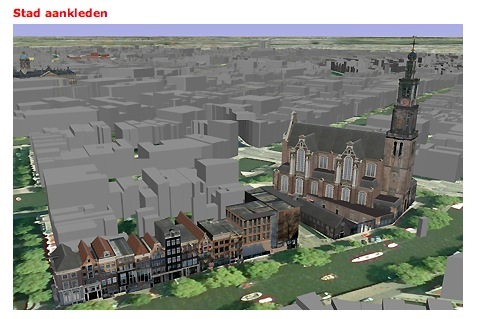
Meanwhile, down on Earth...Just got this link send to me by a collegue. The city of Amsterdam is offering its greyscale 3D representation in Google Earth (blogged about at GEB) to its citizens, offering us to dress up our own city. Its a pity they don't offer an English version of the page, but in short it explains a partnership between Amsterdam and Google and points to a manual on how to build and upload your own user generated buildings to the Google Warehouse. Over at my other blog I just posted a UGO visualisation of the tour of 10 building highlights that have already been modeled by the city's Geo division.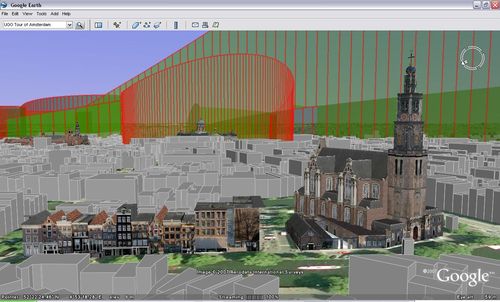
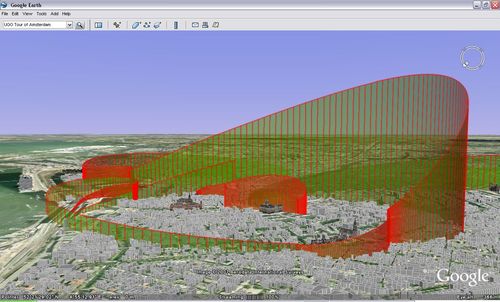
Catch up time
Posted on Tuesday, July 24, 2007
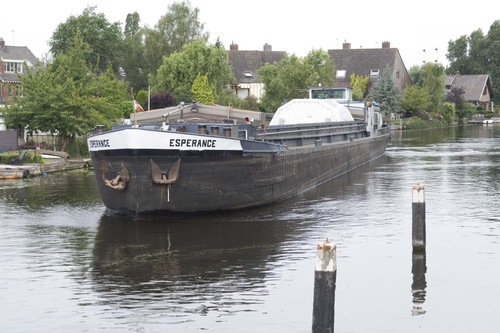
Bloggin' has been sparse these last few weeks, partially because of my latest dive into UGO development. Assuming you read OgleEarth and Google Earth Blog, you are pretty well covered on interesting news coming out these last few weeks. Just a few things worth (re)blogging:
- The Automated Transfer Vehicle (ATV) was transported from ESTEC to Kourou for launch to the ISS next year. There is a nice photo report at ESA, amongst which above photo. A Billion+ craft going through the Dutch canals ;)
- The first Metaverse Roadmap (MVR) is out. An inspiring read!
- NASA has now its own layer inside Google Earth. Still rather rudimentary, like the ESA layer, but a good start. (via Google LatLong blog)
- Barnabu blog posted two space related kml's showing the Moons and the planets in a solar system context (via GEB). Its latest addition, the Cosmic Microwave Background Radiation
- OgleEarth has been ogling Mars. And again. Looking at the word 'ogling' a couple of times, its about time to have a better understanding of what to ogle actually means. As a Dutchman I usually assume I have a comprehension of the English language, but most of the time I know I miss the subtleties of knowing the real English use of a term. For my own understanding, here is the Merrian-Webster dictionary explanation:
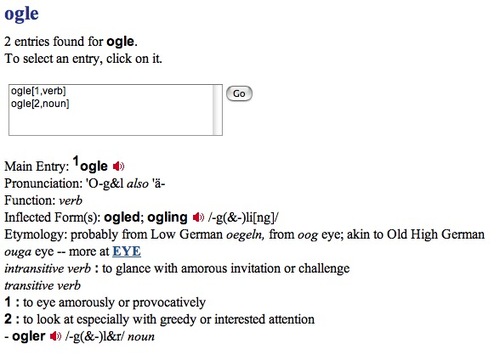
Aha! How about OgleMars.com Stefan? ;)
While I was away
Posted on Wednesday, July 11, 2007
Been to Transformers earlier this week. Great visuals, poor screenplay. One thing was pretty funny. Where Europe mourned the loss of its Beagle2 lander (it was after all a UK lander on an ESA spacecraft), this movie simply infuses the meme that Beagle2 was actually a NASA lander (a rover at that!) which wasn't lost at all, it just brought back some cosmic top secret imagery of Decepticons rooming the red planet. Who said ESA has a PR problem? Check out above video for some serious transformer action.
What's to come...
Posted on Tuesday, July 10, 2007
Going through my RSS feeds today, I found an interesting quote from Jessy Cowan-Sharp, technical platform manager for the Ames CoLab effort, about NASA's move into virtual worlds such as Second Life:
...virtual worlds are "the seed of something that's going to be one of the major transformational technologies of our species."I couldn't agree more. Read the whole story at SpaceDaily.
Where do you NOT want to go today?
Posted on Thursday, July 5, 2007
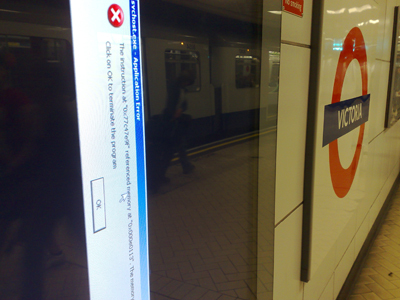
Don't think windows is quite ready yet to get us into outer space ;) The same thing I have seen several times on LCD screens in the public transport here in Amsterdam...nothing more telling than an ad space crashing like that...you just want to press that OK button and get on with...(via edparsons.com)
Happy Birthday Pathfinder
Posted on Wednesday, July 4, 2007
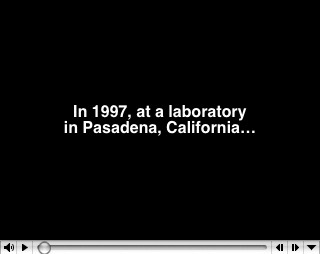
Wow, 10 years ago already. Almost forgot Mars Pathfinder landed on the 4th of July. Seeing the images over a 33k6 modem back then sure was a good inspiration while studying aerospace engineering. When I think of it, it actually got me into the direction which, 10 years later, resulted in the theme of this blog:
A blog about outer space, cyberspace, their common future, and all that is leading up to it...
Virtual Worlds Presentation by Mitch Kapor
Posted on Tuesday, July 3, 2007
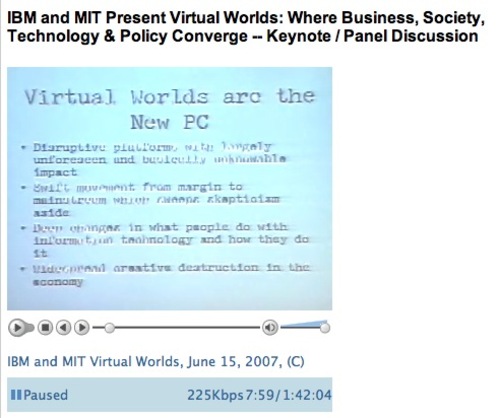
Over the weekend I stumbled on this 1:42:04 video of Mitch Kapor (of Lotus fame and an early investor in SecondLife) giving a presentation and leading a panel at the MIT Virtual Worlds laboratory June 15 (just 2 weeks ago!). Interesting watch/listen! I am still a bit skeptical about all this virtual world stuff, but like he says, this seems more to do with the feeling of knowing there is something going on but that its hard to articulate what it exactly is. For everybody interested in getting a good introduction about virtual worlds, do watch/listen the whole video.
The panel discussion is also worth noting. I especially like the comment by Robert Gehorsham (with Forterra) at 1:22:23 into the video about the self-imposed limitation of 'only' rebuilding real3D into a virtual platform. Somebody throws in: 'locked into assumptions'. Good point. Lets use virtual worlds to flex our limits within the Powers Of Ten, not stick with the human scale only (there is enough of that around already). Here are two other interesting scribbles from watching the video: reality acquisition devices & ROI on mystical experiences. And not to forget, the quote of the day: Please don't metaphor me in!. Btw, there is a new 6min talk by MS Virtual Earth PM over at TED.com
Human-Machine-Nature interfaces
Posted on Monday, June 25, 2007
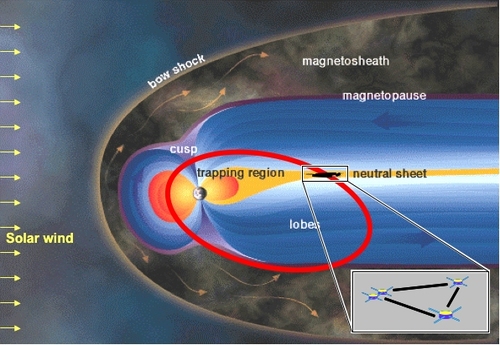
Quite some news recently about human-machine interfaces coming out. In particular the non-intrusive ones like this collaboration between Graz and University of London (check out this video ;). Not related, but OgleEarth is back at blogging, and he brings back some cool footage from ISDE5. Like he says, a possible hint at where things might be going with digital globes. Now what i'd like to see is a near real time vis of the Cluster data in one of these domes...magnetosphere storms as they happen...These four ESA satellites are up there now, so how difficult could that be?
Oh, and a quick note about an interesting conference coming up:
- The 11th International Conference on Information Visualisation from 2-6 July, interconnected with this Vizualisation summit
Participatory Exploration
Posted on Monday, June 25, 2007
Just in:
- An article about Pete Worden's talk at the ISDC through Second Life
- NASA Ames to Host Summit of Technology and Communications Experts
Hop aboard LCROSS
Posted on Wednesday, June 13, 2007
Following up on Pete Worden's talk through Second Life linked to below, here are two KQED videos I found (1, 2) which shed some light on the LCROSS mission to be launched October next year. According to Pete's remarks in the presentation, this is the mission which should allow people to virtually fly along to the Moon.
The first video is an animation which details the complete mission scenario, including the LRO mission scenario to be launched in parallel with the LCROSS spacecraft. What's interesting about the LCROSS mission scenario on first sight is that it includes an 80-day period in which it orbits the Earth at Moon's distance in order to synchronise its impact point on the Lunar surface at minimum fuel cost. Turns out this is very much the same as a mission I once worked on called LunarSat which used a Weak Stability Boundary orbit to do more or less the same (except for impacting). Would be cool to have the camera beaming down a continuous stream of Earth looking images during this period (like EarthViews was designed to do for LunarSat).
Taking Pete's talk into consideration, I am sure they are working on that right now, which makes me wonder through what interface they are planning to show these images? Seems to me a virtual globe like Google Earth is perfectly suited for this. You'd get something of a 'photosynth' of the Earth through robotic satellite means ;)
The occasional 'space related' art post
Posted on Tuesday, June 12, 2007
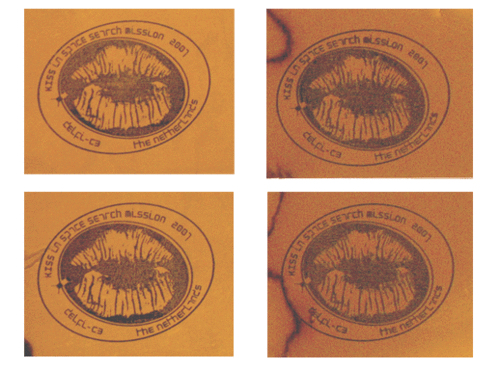
There hasn't been much ado about space art space related(!) art on this blog since the publishing of the ISS Cultural Utilisation policy recommendations back in early spring 2006. ESA is still in the works on the topic, and unofficially all kinds of stuff is happening, but out in the open, its quiet...very quiet...untill I was reminded by a collegue over at Delta-Utec about this space art project at the TU Delft. Not sure what to make of it, but nevertheless nice to see the meme is still catching on. And while we're at it, Jeremy Hight (of locative media art fame) just published a new article about immersive sight. Inspiring stuff!
SimonPete Raymaker and other 2nd Life news
Posted on Monday, June 11, 2007
Coming back to Amsterdam after a long-deserved couple of days holiday at the beach in Knokke (.kmz), here is a brief overview of some interesting stories (IMHO):
- NASA Ames Director Pete Worden presents to the International Space Development Conference via Second Life. Now here is a retired US General who definitely gets it ;) A lot of interesting stuff is originating from Ames since he became center director (e.g. Google NASA partnership, NASA CoLab, Yuri's night @ Ames), and listening to this talk I am sure there is lots more coming!
- Following the Second Life meme, this is one of the most intruiging pieces of Second Life coverage I have seen sofar. Its the established political scene in Sweden getting introduced to a 21st century technology, including the cutting of a digital ribbon (well, sort of...;) OgleEarth has (a lot) more on the story (he was the cameraman).
- Something I noticed myself a week or so ago, and after reading this post, was reminded about it again: the stars seem to be moving in Google Earth. Is this the start of something new?
Disallow: bedroom
Posted on Thursday, May 31, 2007
Where2.0 is happening so lots to blog (e.g. Google Street View, KML 2.2 etc) but little time, so this one says it all for now:

(via spatially adjusted)
Here are a few other stories worth reading: RSS for the genes, Charlie's Diary: Shaping the future, The Final Days of Google, blog statistics are a drug (I can relate...)
Hybrid World Lab
Posted on Sunday, May 13, 2007
Now this is a workshop I would have loved to go to, but missed unfortunately. Some powerpoints in pdf are available from Nicolas Nova and Timo Arnall. And here is a reader for the workshop (which just finished last friday...).
Light posting ahead
Posted on Saturday, May 12, 2007
Haven't been very active on this blog lately, which is mainly due to my full focus on the development of my UGO project, making me less susceptible to reading my section of the blogosphere on all the news coming out on a daily basis. I haven't finished my first build yet, so this light posting will likely continue for the coming days/weeks untill I finalise a first UGO app. In the meantime, some interesting developments worth noting:
- Search Engine Land (definitely a good read)
- a joke
- Anil Dash post
- News.com
And of course there is the news of a new WorldWind JAVA release.
Updated blog feed
Posted on Tuesday, May 1, 2007
Mmm, turns out I already had a FeedBurner account with several subscribed readers to this blog (re: earlier post). Strange how things like feeds can get this complicated...;) Anyway, to keep things organised I decided to delete the new account and merge its feed with the already existing one. For those of you who subscribed to the new one in recent weeks, please visit my blog's webpage and (re)-subscribe one more time to the FeedBurner link on the right.
To check if you have the correct feed, the correct FeedBurner account should now have the following URL: http://feeds.feedburner.com/tobedetermined (for Safari on OSX this should read: feed://feeds.feedburner.com/tobedetermined)
Thanx again...
Expanding Digital Universe
Posted on Tuesday, April 10, 2007
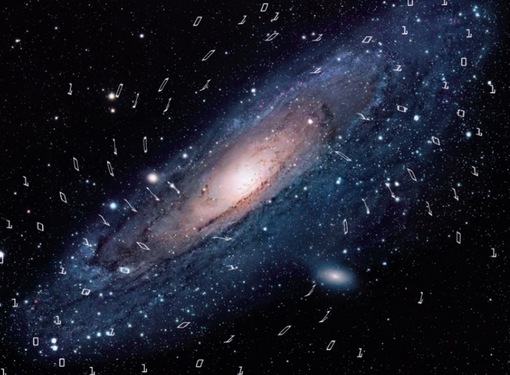
Naive as it may seem, I kind a like this cover image in the report: The Expanding Digital Universe: A Forecast of Worldwide Information Growth Through 2010. The Guardian reports... (via).
FBTO gives its roof a paint job
Posted on Wednesday, April 4, 2007

Dutch insurance company FBTO took no risk and painted its corporate logo on its roof to show up in the next update of Google Earth (Via MarketingFacts, in Dutch). Here is a video entitled 'Google Kijkt Mee (Google Watches Along)' where FBTO marketing manager Paul Koopman explains the why and how (in Dutch). Wouldn't it be handy if Google had a listing online of its planned database updates, just like they did earlier this year down under. I have a pretty large roof myself, which I wouldn't mind decorating if only I knew when to do it.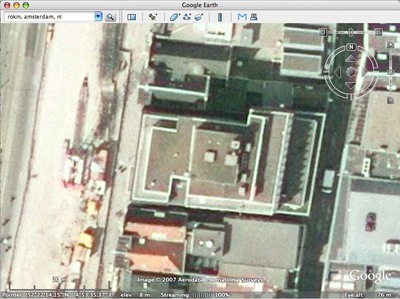
"...Is it really real...?
Posted on Monday, April 2, 2007
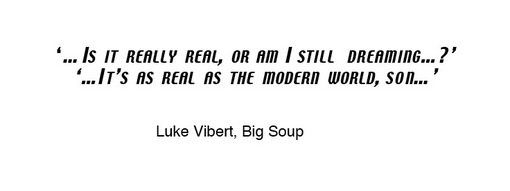
This quote from a song by Luke Vibert (which became my mantra while writing my thesis back in 2000) came back to me when reading below quote from Henry Jenkins from Peter Ludlow in an interview with Henry Jenkins talking about Second Life (via Trevor F. Smith):
The more interesting question is why people keep repeating ""only a game"" so much. If you google ""only a game"" and "Second Life" together, you get nearly 12,000 hits. It is like a mantra that people keep repeating to keep some thought or idea at bay - and I think the dangerous idea that Second Life shoves in your face every day is this: our wealth is virtual, our property is transient, and our social lives are mediated by technology, nomadic, and often fleeting. I think that when people keep saying "it''s only a game" they are really saying "the rest of my world isn''t like this: my wealth is tangible and permanent, my friendships are unmediated and also permanent." Saying "it''s only a game" is like saying "this isn''t how things really are, this is just a bad dream." People need to pinch themselves, because this ain''t no dream. This is reality; deal with it.More where this came from at an interview with Peter Ludlow.
Space xplo in virtual space
Posted on Sunday, April 1, 2007
NASA budgets for development of MMO & Worldspaceparty
Posted on Tuesday, March 27, 2007
Another example of 'NASA gets it...the others follow': NASA moving into virtual world development:
To successfully advance the Vision for Space Exploration (VSE), NASA is continually refocusing and streamlining its organization, realigning ongoing programs, and tapping the innovative talents of our nation. To accomplish the VSE goals of returning to the moon and going beyond to Mars, NASA must find ways to enhanced science, technology, engineering and mathematics (STEM) education. This intramural call for proposal ideas seeks to develop a persistent, online, synthetic environment that will support NASA's STEM education goals and allow millions more American to share in the experience of NASA science and exploration virtually.Read more about this particular solicitation (16-page pdf) at 3pointD.com (the call seems to have been postponed). Seems to follows neatly along the lines of a NASA activity that has already been going on for some time: NASA CoLab:
NASA CoLab is a Collaborative Space Exploration Lab being developed at NASA. CoLab will provide a framework for exciting partnership projects between the nation’s space program and the thriving technology-entrepreneurial community. In addition to the benefits to collaborating with intellectual assets of the technology business sector, the general public will benefit through various projects supporting the NASA’s goals. CoLab will feature a physical space in downtown San Francisco, a collaborative online space where scientists and engineers from NASA will collaborate with the entrepreneurial technology community, and a space in “Second Life”, a virtual learning community with interactive content.This also reminds me: forget Easter, its WorldSpaceParty time. Some of the people I met while over in Cupertino are taking part in the organisation of this once in a lifetime party commemorating the 50th anniversary of the Sputnik launch, while at the same time celebrating the annual Yuri's night which is held all over the globe. Located in a hanger on NASA Ames premises, the event includes amongst others a concert by Plaid (enough reason already to go over there) and also hosts several space art exhibitions. In case you can't make it over to California, there is always the opportunity to visit the party through your second life ;)
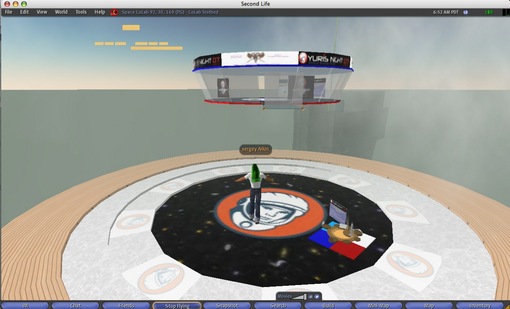
Click to enlarge
FeedBurner goes outer space...
Posted on Tuesday, March 27, 2007
Finally...where can I sign up for a feed from the Mars Exploration Rovers or, say, the International Space Station?
A couple of months ago I stumbled upon this ad by FeedBurner which I found kind of intruiging. Thinking about the convergence of user generated content, games like Spore, collective intelligence, NASA teaming up with Google, Google Earth becoming more mainstream, locative media art, blogjects, my project with Jeremy hight 'Floating points', The Internet of Things, advertisements 'in space' and satellites as blogging objects, it seemed they tapped into the right kind of nerve with this particular add. There won't be anybody blogging from Jupiter anytime soon, but considering that satellites have been blogging since the early days of Sputnik (audio), the idea of the blogosphere moving into outer space doesn't strike me as all too crazy (let alone the advertising dollars). The main question that strikes me is: what would somebody something near Jupiter blog about? Any thoughts?
(note: the above flash file was kindly provided to me by FeedBurner after some back and forth communication on my request to host the ad on my blog. Sofar, I haven't been able to make the click-through URL for this particular ad work, so in return I am happy to host their FeedBurner ads URL. Thanks Jessica.)
Cyberspace or the metaverse?
Posted on Thursday, March 22, 2007
Update Monday 26th March: The lecture of Bruce Sterling is available here (649 Mb Quicktime)
Soon, here will likely be the online video of Bruce Sterling's talk tonight at 'Pakhuis 't Zwijger', 2nd in line, about an hour into the evening programme. Felt like he was off to a slow start, but had some pleasant rides along the way ;)
After this cyberspace revisit, I just uploaded a talk I found on my harddrive from Michael T Jones (Google CTO, must be from Where2.0 2006, but can't find it anywhere anymore online). For me, its the follow up on his other highly inspirational talk. And here's an interesting press release from Bruce Sterling's blog on a conference on locative media.
Spore
Posted on Saturday, March 17, 2007
Update saturday March 17th: I thought this already happened a few weeks ago, but only now is there an official announcement that Google acquired AdScape, an in-game advertisement company. Seems to fit nicely with the objective of user generated game content...mix that with Spore and you get "Evolution, sponsored by Adsense".
Following a lead from a blogpost @ 3pointD on the SXSW conference, where Will Wright gave a keynote, I stumble upon a game currently under development which totally blows me away. Working title 'Spore'. Below are some videos where Will Wright demos the game. Its amazing: how could I have missed this one? The videos have had over 2 million views. Kind of brings the whole point of the merger of outer space and cyberspace home. Mission accomplished. Blog closed till further notice ;)
Interesting note on the first video is the commentary by Will Wright. Watching it from a distance, I am surprised how much the intonation of his voice resembles that of Google Earth CTO Michael T Jones in this seminal 2005 presentation on Google Earth (if you haven't watch this presentation, do...its definitely worth it). I wonder what happens if you overlay Will Wright's video with the audio track of Michael Jones...would anybody notice? Anyway, the concept implemented in Spore gives some interesting clues as to where the combination of collective intelligence, user generated content and space exploration might end up in the future (harnassing, leveraging etc, you know the drill). Oh, and btw, Will Wright is the guy from Simcity and the Sims in case you wondered. Here is an interview with Will Wright on Spore in Popular Science.
Spore gameplay video (February 2006)
Spore demo from E3 2006 (may 2006)
Mars flyovers
Posted on Saturday, March 17, 2007
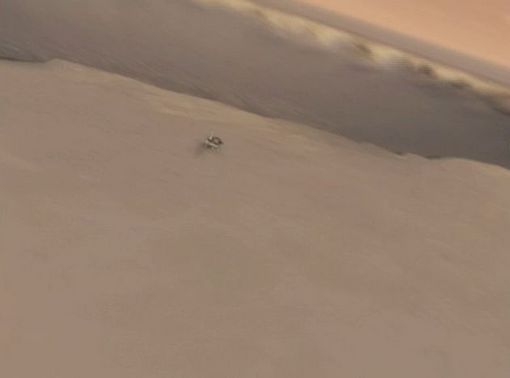
Two impressive Mars flyover videos were released last week by NASA, one for each of the two rovers Spirit and Opportunity (via Nasa Watch). If this technology is available on the MRO satellite, I wonder what is possible with this technology for Earth orbiting satellites.
Flying to the moon
Posted on Saturday, March 17, 2007
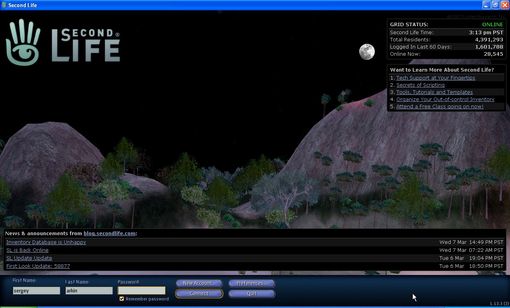
Click to enlarge
Still trying to get back into Second Life after I lost my password...the help line doesn't do much...let alone trying to get a new free login...hope they solve their my problem before NASA gets back to the Moon in First Life.
Computer liebe
Posted on Tuesday, March 6, 2007
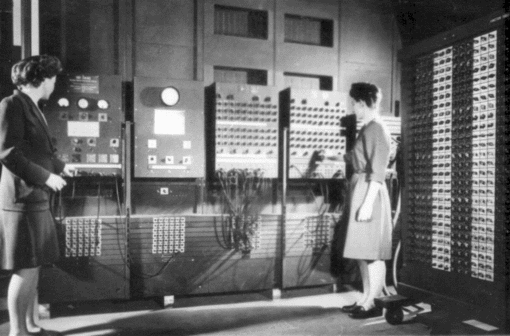
Via Jurryt Pietersma, did you know this (from an interview with J. Presper Eckert, co-inventor of the ENIAC):
Q: So it's a myth that ENIAC could only add, subtract, multiply and divide?Sweet...More at computerworld.com.
A: No, that's a calculator. ENIAC could do three-dimensional, second-order differential equations. We were calculating trajectory tables for the war effort. In those days. The trajectory tables were calculated by hundreds of people operating desk calculators -- people who were called computers. So the machine that does that work was called a computer.
Btw, for those of you in the Netherlands, I just discovered this series of lectures that could be of interest to you: cybersalvations. Here is the line-up:
March 21:
Bruce Sterling (science fiction writer, design visionairy) &
Peter Pels (anthropology, Leiden University)
Moderator: Sally Wyatt (Virtual Knowledge Studio, former president of the European Association for the Study of Science and Technology)April 11:
Rudy Rucker (science fiction writer, mathematics professor)
RU Sirius (founder cyberculture magazine ‘Mondo 2000’)
Moderator: Giselinde Kuipers (sociology, University of Amsterdam)May 2:
Brenda Laurel (virtual worlds and game designer)
Bruce Damer and Galen Brandt (virtual worlds developers and performers)
Moderator: Christian van ‘t Hof (Rathenau Institute)Location: Pakhuis de Zwijger, Piet Heinkade 179, Amsterdam
Start: 19.45 uur
Entrance: Free
Europe ahead of itself
Posted on Sunday, March 4, 2007
After Sweden opened the first embassy in Second Life last month, now nu.nl has the story (in Dutch) that the European Commission is studying opening up a European Commission office in Second Life. What's going on here...?
Trying to get back into Second Life over the weekend to have a look at the embassy (amongst other things), I am surprised to learn that I am locked out of my second life because (1) if forgot my password (could only just remember my ackward name Sergey Arkin) and (2) in order to reset my password, I need to give the answer to the captcha ''what is your pet's name'....but I don't even have a pet, let alone that I would remember what I filled in at the time I was making the trial account (usually its something like 'qwerty' or 'qwerty@qwerty.com')...there is clearly a need for some better ID management here. Maybe the European Commission can start by giving each European a unique and personal digital identity while they are at it, instead of just hobby-horsing extending their own little Brussels island into the virtual domain...
But...but, where's the singularity?
Posted on Sunday, March 4, 2007
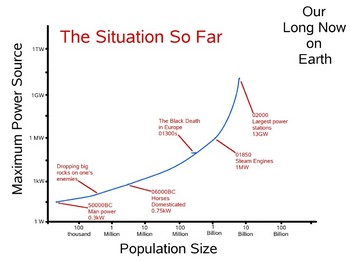
Vernor Vinge recently gave a talk at the Long Now foundation: What if the Singularity does NOT happen.
....It's 2040 and nerds in old-folks homes are wandering around, scratching their heads, and asking plaintively, "But ... but, where's the Singularity?"...As part of his excursion into possible future scenarios for humankind in case the singularity does not happen, he explores the importance of human space flight as a way to secure our long term future. His conclusions sofar:
Humankind's presence in space is essential to long-term human survival.
That is why I urge that we reject any major humans-in-space initiative that does not have the prerequisite goal of much cheaper (at least by a factor of ten) access to space.
Makes sense. Not so sure though if I agree with the idea of human spaceflight as being essential for our future survival, but that doubt is more to do with the notion of 'humans-in-space' compared to that of 'humankind's presence in space'.
KML Search explained
Posted on Sunday, March 4, 2007
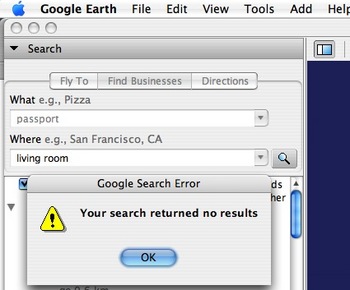
Directions Magazine has an informative graphic explanation of KML search.
update Sunday March 4th: Another informative article on the same topic at internetnews.com (via OgleEarth).
traceroute Rosetta
Posted on Tuesday, February 27, 2007
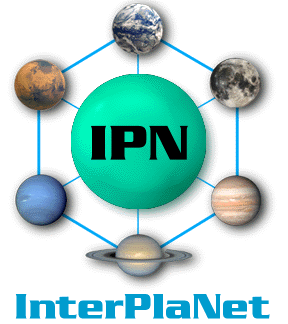
Related to my previous post on Rosetta's view of Mars, I just read on Slashdot about the plan Vint Cerf is working on to expand the Internet into the Solar System:
Communication between a rover operator on Earth and a rover on Mars, via a relay orbiter, can't use standard Internet protocols end-to-end. That problem is at the root of a lot of the design work we're doing for the IPN... As part of the NASA Mars mission programme, the project aims to have by 2008 a well-functioning Earth-Mars network.An excellent read I must say, the Slashdot discussion, especially because only at the very bottom of the page does it actually start talking sense, the rest is just geeks getting off on geekjokes. Thought this one was quite to the point:
Parts of this planet we live on don't even have access to a broadband Internet connection, and now they want to plug Mars on the network? Talk about priorities...But then again:
parts of this planet are even more worthless than the lifeless Mars. Leave the stragglers behind..keep pushing forward. -they don't call it the human race for nothing
The idea to expand IP into the Solar System has been around for a while, and to me it obviously makes perfect sense. Evolution you might say. It has been working in Low Earth Orbit onboard an SSTL satellite for quite a while already (video @ Cisco), and Cisco is seriously interested to get deeper into the game.
KML search capability: hurricane+katrina
Posted on Tuesday, February 20, 2007
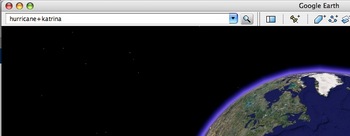
Click to enlarge
OgleEarth and Directions Magazine have the news of a KML search capability recently announced by Google on their maps API blog.
Leaving the discussion on the licensing of Google Earth @ work for a moment, here is an intruiging thought I like from Allen Doyle discussing the release:
But, hey! It's a start. The buzz is there. It's easy to post KML files. How hard would it be to post the entire metadata holdings of a large geospatial data provider like NASA or NOAA in KML? I bet a service like GCMD could post theirs in a week. At Where 2.0, we could be watching demos of Google Earth finding, and displaying, realtime remote sensing data.Makes me wonder what an HTM would have to say about the patterns?
Btw, below is what Google Earth now comes up with searching for 'hurricane+katrina'. Fairfield Inn by Marriot? Not exactly what I was looking for...although...mmm, maybe...if it were realtime data ;)
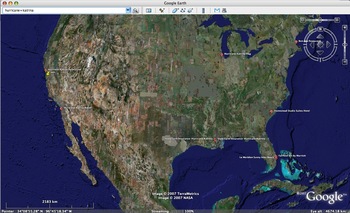
Click to enlarge
Mars rovers on Earth
Posted on Tuesday, February 20, 2007
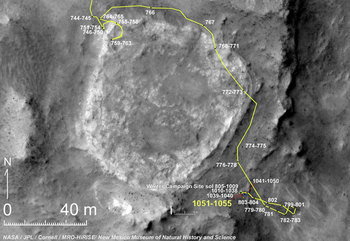
Click to enlarge
Thinking about a project by c5 I read about in Jeremy Hight's text on Floating Points:
Now groups such as the C5 collective are doing work such as the GPS mapping of the entire great wall of china and then placing the coordinates in another location. This type of work creates a layered commentary and plays with form and semiotics as well as referencing the Situationists who developed absurd commentaries like a walk through the streets of Paris following a map of another city.
I had an idea: lets digitally translate the trajectories of the 2 Mars rovers to a suitable location on (Google) Earth.
Chinese ASAT test analysis in Google Earth
Posted on Sunday, February 18, 2007
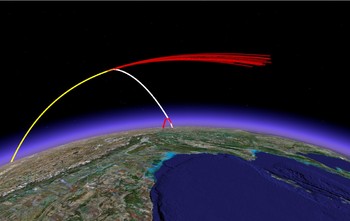
Click to enlarge
Catching up on my blog role after a week of virtually no second life activities (is that proper English?), I come across a post at OgleEarth on the Chinese Anti-Satellite test I blogged about last month. Turns out researchers at MIT's Science, Technology and Global Security Working Group did exactly what I was looking for: a visualisation of the satellite kill in Google Earth.
Apart from the kml file displaying above scene in Google Earth (which as yet appears to be a static visualisation only), they also issued a report on the same website which gives some further analysis of the event. It is here that I am happy to find the first (well, actually 2nd ;-) online evidence of the use of Google Earth for actual visualisation in the realm of space engineering and analysis beyond mere pretty images (see images at bottom of this post).
Scanning through the document, it seems the program they made the analysis with is a recently released stand-alone program to calculate ballistic missile trajectories which has a direct output to Google Earth. From their website:
GUI_Missile_Flyout is a stand-alone program running under Windows for simulating ballistic missiles with 1, 2, or 3 stages in a framework with a round, rotating Earth. Users can easily input all the necessary parameters in an intuitive graphical user interface (GUI). A modest number of quantities can be interactively plotted on the Interface but the complete trajectory can be saved as either an Excel or Matlab file for further analysis. The trajectory can also be directly displayed in Google Earth for visualization. The GUI can be used to optimize gravity turn parameters to maximize range or aim at a specific target (entered, as is the launch site) through latitude-longitude pairs. In addition to an introduction to using the program, this paper describes the integration of the three-degrees-of-freedom equations of motion and approximations made to the aerodynamic (such as a parameterized drag coefficient, Cd).Incorporating the option to directly output to Google Earth readible format is something that has been occuring on a frequent basis in the traditional GIS field but I haven't heard of it yet in the space arena. I wonder for example what STK's strategy is in this respect? They have their own AGI viewer, but as with all the different GIS viewers, who is interested to have all these different systems installed when Google Earth can handle them all at once, and on top of that is also cross-platform (which most sophisticated analysis tools are certainly not yet).
If you use this program for a publication, please reference: Geoffrey Forden, “GUI_Missile_Flyout: A General Program for Simulating Ballistic Missiles”, submitted to Science and Global Security. December 2006.
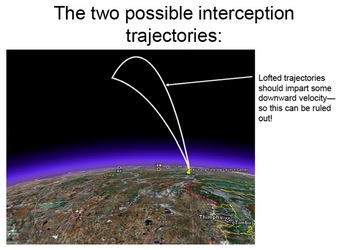
Click to enlarge
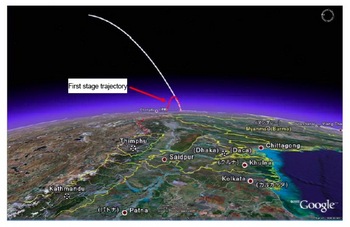
Click to enlarge
Google is coming to town
Posted on Friday, February 9, 2007

Well, not exactly Amsterdam, but the Netherlands at least: Google opens datacenter at Eemshaven (near Groningen) (in Dutch).
Here we go: locative media branding
Posted on Thursday, February 8, 2007
"The advent of Internet-based flight tracking technology enables an entirely new kind of skywriting. Gulfstream Aerospace sent up one of their $50M business jets today on an 8.5-hour test flight spanning 11 states for the sole purpose of leaving their mark on the Net in the form of a flight track that spells out 'GV' (the nickname of the Gulfstream V aircraft being flown) when viewed online."(via MIT's Advertising Lab blog)
On a similar note, at BoingBoing: Radar of corporate jets leaving the Superbowl
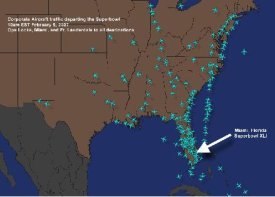
I hope we get to see some of this in space as well, before its too late...
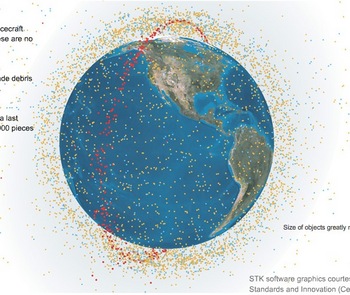
Communications & travel
Posted on Wednesday, January 31, 2007
From an interesting piece by Clay Shirky:
Jaron Lanier is the Charles Babbage of Our GenerationHere we arrive at the furthest shores of speculation. One of the basic promises of virtual reality, at least in its Snow Crash-inflected version, is that we will be able to re-create the full sense of being in someone's presence in a mediated environment. This has been a human desire at least since Shamash appeared to Gilgamesh in a dream. Re-stated in technological terms, this version of virtual reality is a belief that communications will finally become an adequate substitute for travel. We have been promised that this will soon be achieved with current technology since ATT demoed a video phone at the 1964 World's Fair.
I believe this version of virtual reality will in fact come to pass, someday. I do not, however, believe that it will involve a screen. Trying to trick the brain by tricking the eyes is a mug's game. The brain is richly arrayed with tools to detect and unmask visual trickery -- if the eyes are misreporting, the brain falls back on other externally focussed senses like touch and smell, or internally focussed ones like balance and proprioception.
Though the conception of virtual reality is clear, the technologies we have today are inadequate to the task. In the same way that the theory of computation arose in the mechanical age, but had to wait first for electrics and then electronics to be fully realized, general purpose virtual reality is an idea waiting on a technology, and specifically on neural interface, which will allow us to trick the brain by tricking the brain. (The neural interface in turn waits on trifling details like an explanation of consciousness.)
In the meantime, the 3D worlds program in the next decade is likely to resemble the AI program in the last century, where early optimism about rapid progress on general frameworks gave way to disconnected research topics (machine vision, natural language processing) and 'toy worlds' environments. We will continue to see valuable but specific uses for immersive environments, from flight training and architectural flythroughs to pain relief for burn victims and treatment for acrophobia. These are all indisputably good things, but they are not themselves general, and more importantly don't suggest rapid progress on generality. As a result, games will continue to dominate the list of well-populated environments for the foreseeable future, rendering ineffectual the category of virtual worlds, and, critically, many of the predictions being attached thereunto.
Just in: Google's virtual world
Posted on Thursday, January 25, 2007
Update: seems this meme touches a nerve, cause it is spreading to where I normally don't see any discussions on Google Earth or Second life, such as the blog by John Battelle.
The rumor continues...Google's Metaverse (via Google Earth Blog). Best comment sofar by Tom Churn:
If you work in this industry, you’re already living in Google’s Virtual World. At least, for about 10 hours a day…
As always, Brownian Emotion has an interesting perspective on things, like:
Rumors persist that Google is in the process of turning Google Earth into a virtual world. Well, I hate to burst anyone’s bubble, but GE already is a virtual world. It’s a virtual earth. It has all of the features of a virtual world (spatiality, point of view, presence, information modeling), minus a few we’ve come to expect from a game or socially-oriented space (seeing yourself, seeing other people, and directly interacting togther).
Reading his post, I was thinking the same thing as I just read on OgleEarth: it maybe so that for planet Earth Google Earth is a mirror world and not a virtual one, but what about all those other worlds out there? What about Mars for example? Is there any (evolutionary?) logic in allowing people to build a virtual world ontop of Mars imagery...I mean...no one is going to get there anytime soon except for some robotic explorers, so apart from the imagery, there is not really the chance of mixing up the 'real' world with a customly-designed virtual one. The only question is: what is the added value of building a virtual world as a mashup on another planet, instead of creating a completely user-generated SL type of virtual world?
Google Earth Panorama Viewer
Posted on Thursday, January 25, 2007
One more thingGUI: the Google Earth Panorama Viewer. This one is definitely here to stay and evolve to even more immersiveness. Its beautiful, even in its current 'crude' state. Created by Digital Urban, it has been making quite some furore in the blogosphere (like OgleEarth, Google Earth Blog and MAKE blog). Check out the above video (I am not so sure about the music...you might wanna turn it off ;-) and have a look at this tutorial and some other panoramas at the Digital Urban blog.
It ties in with the Gigapan camera project I learned about while over at NASA Ames last year in combination with Brownian Emotion discussing a possible next step for Google Earth, where these panoramas would be viewed not outside Google's Earth as a separate sphere but inside of it :
As a exercise, imagine yourself inside the Google Earth, assuming it’s hollow and the imagery you usually see sits on a thin glass shell that can be viewed from inside as well as outside the Earth. If you’re in the center of the sphere, what you’re seeing is essentially the same as a virtual panorama. The same mouse controls that let you spin the Earth now let you spin the panorama from the inside, grabbing that shell like you’d grab the ground. The main difference between this and flying up above the Earth, apart from the imagery and the source, is just the point of view of the observer.
Gibson on space travel
Posted on Thursday, January 25, 2007
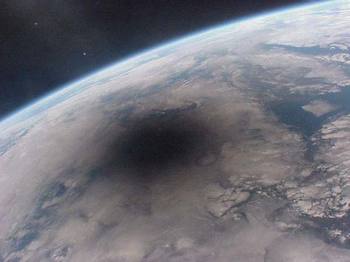
If the ideas of contemporary science fiction writers is anything to go by, here is an interesting interview with William Gibson from back in 1999, where amongst other things, he says the following:
While we were dreaming about spreading our chromosomes, the species was spinning this prosthetic nervous system for itself, and that's what's driving social change now. It's not legislation, it's not population pressures. Where we're going is the result of emerging technologies, and that's terribly rich ground for a science fiction writer.The above image of a Solar eclipse as seen from space is one of the last images made from the MIR station before it was brought down in 2001. In the interview, Gibson specifically refers to it, saying:
I was really deeply moved by one of the last photographs to come out of that station, an image of the Earth seen during the solar eclipse. I thought to myself, "we've never had that camera angle before.
Btw, if the space.com website is any hint at what the main internet portal to outer space will be like (its one of the more popular space related websites at the moment I believe), there is still lots of work to be done...the design is just...well...terrible...!
Project Excelsior
Posted on Sunday, January 21, 2007
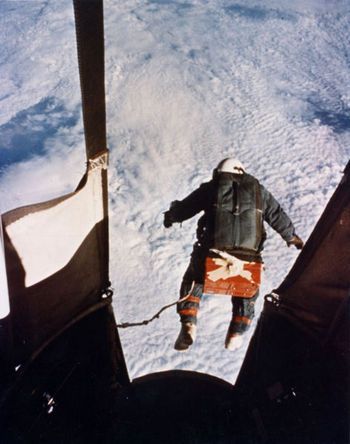
Too bad Joseph Kittinger wasn't carrying a GPS device at the time he jumped out of his balloon carriage back in 1960 (GPS, 1960?). Would be interesting to see his jump in Google Earth. Kind of a space tourism 0.1. Just saw his footage in a clip from Boards of Canada.
Highly relevant ads
Posted on Sunday, January 21, 2007
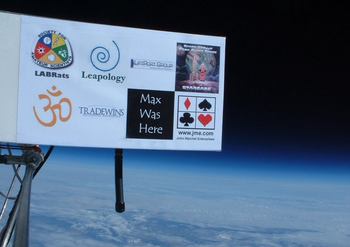
Click to enlarge
Following news on Google's possible acquirement of an in-game advertising firm (first read on OgleEarth), I finally found a reason to upload this image on advertisements in space...When will Google's next ad frontier (WSJ subscription) coincide with the final frontier, either real or virtual? Is there really anything against serving highly relevant ads once people start returning to the Moon? And would it be able to support some good space exploration initiatives? Or even better, some new Earth Observation missions following the warning from the US National Academy of Sciences that the US is underfunding its EO capabilities in the years to come (WSJ editorial: blinding ourselves in space). Its basically in our own interest to have these missions, so why not fund them through Google Adsense...
Tobedetermined finds...Agents of Evolution
Posted on Wednesday, January 17, 2007
- Futurist Peter Schwartz introduces an interesting term new to me in this article: Agents of Evolution
- O'Reilly Radar: Measuring a virtual world and If Google were a restaurant
- How about one of the above cameras onboard the ISS?
- Back to the 50's: China destroys old weather satellite
- Google wants YOU! in Google Earth: Google's Australia Day 2007 aerial photography. Turns out, Microsoft is planning to do the same, with the oh, so Microsofty catchphrase 'Look Up and Smile this Australia Day'
- The archives: Google's Master Plan
Geostationary playground
Posted on Tuesday, January 16, 2007
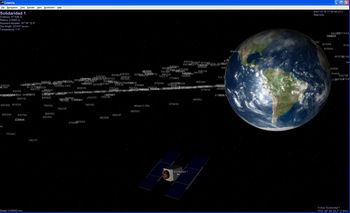
Click to enlarge
Thinking about how 3 dimensional outer space could be represented inside virtual globe environments, I spent some time flying around the Solar System in Celestia. Incorporating some of the satellite plugins available at the Celestia Motherlode, I managed to get the Geostationary ring become visible with all its +100 telecommunication satellites. The nice thing about Celestia is that it allows you to lock onto any object you happen to pass by, so zooming into the individual satellites now visible, I circled the Earth by hopping from one satellite to the next. Funny enough, it actually did gave me a feel of being 'out there', looking down at the Earth from 35,786 km altitude.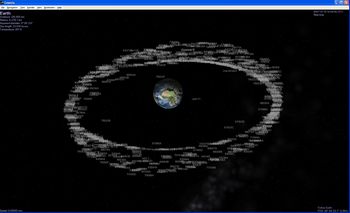
Click to enlarge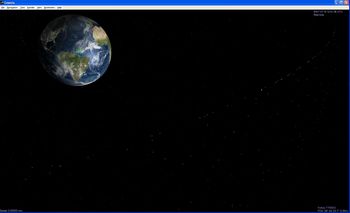
Click to enlarge
10 years later: MRO pinpoints Mars Pathfinder
Posted on Friday, January 12, 2007
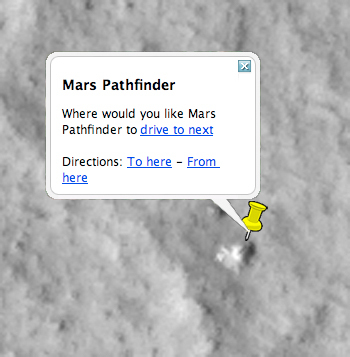
NASA's Mars Pathfinder landed on Mars on July 4, 1997. Just under 10 years later, Mars Reconnaissance Orbiter (MRO) returns to what I recall as the web1.0 highlight of the ongoing merger between outer space and cyberspace. With its Google Earth look-from-above feel, I can hardly wait till this image is Mars-referenced available in Google Mars. More images and stories available at NASA's Mars Pathfinder Landing Site and Surroundings.
click to enlarge
Google's Earth anno 2007
Posted on Friday, January 12, 2007
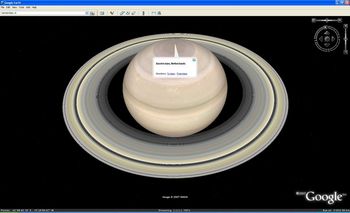
Click to enlarge
Mmm, seems global warming really started kicking in last year (via GEB).
Google Earth zeitgeist
Posted on Friday, January 12, 2007
How about a Google Earth zeitgeist, served to you as a kml overlay, or, while we're at it, why not as a dedicated layer inside GE? One where we get to see the most popular places looked at in Google Earth, categorised by lat/lon, altitude and some other specifics? One advantage: there is no need to filter out such terms as sex and alike.
Another idea I just had, how about airlines providing GE-ready GPS trails of the flight you just got off from. You provide your email address while on the plane, and once you land its automatically send to your email box. Nice for some post-flight recollection of what exactly you saw in that twilight zone state when you opened your eyes those 5 seconds and looked out the window before finding another 'comfortable' position to fall back to sleep in. This happened to me on a flight to San Francisco last year where I have vague memories of seeing polar bears fly next to the plane when we passed over the American continent half way up the artic.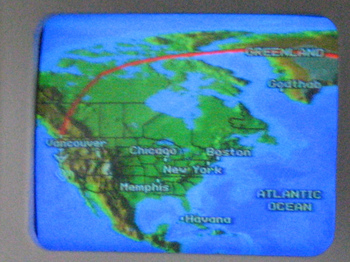
A live flight tracking is already available.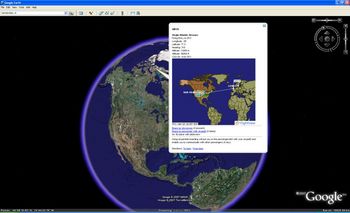
Click to enlarge
With a GPS trail, it could look something like GoogleEarthBlog's trip back from Las Cruces.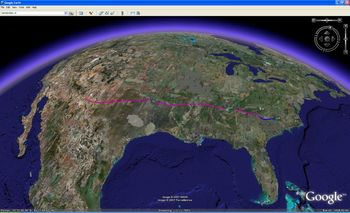
Click to enlarge
tobedetermined finds...
Posted on Monday, January 8, 2007
- Just in: Google teams up with a large group of universities, research institutions and private companies to become the archival experts for the Large Synoptic Survey Telescope (via OgleEarth). Makes sense to me ;)
- Backlog: OgleEarth shares some interesting reflections in this post on the possibilities following December's collaboration announcement between Google and NASA.
- This year is the 50th anniversary of the launch of the first articificial satellite Sputnik in October 4th 1957 (Listen to the sound of Sputnik as it passed over in those days). This weekend's M special of the Dutch newspaper NRC handelsblad is all about the Internet. Their introduction (my translation):
1 billion Earthlings connected to the Internet
50 years ago the Russians launched their Sputnik. The Americans got scared shitless and developed an invulnerable military information network which saw the birth of the Internet. Today, the net belongs to the massess. - ESA news: First 3D map of the Universe's dark matter scaffolding
- Google Earth Blog has the story of a French company Pict'Earth offering a remote control plane with camera capturing realtime images for Google Earth. OgleEarth picked up the story and expands on it
- Webcasts are available from the 2nd Space Exploration Conference in Houston 4-6 December last year. Unfortunately they're coded in Realplayer, so no offline viewing/listening
Navigating outer space
Posted on Friday, January 5, 2007
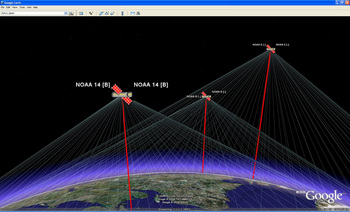
Click to enlarge
Update monday 8 January: I have edited most of below text yesterday after originally posting it on saturday evening. Reading through it again, I noticed how it touches upon a relevant aspect for me of the mediation of outer space through cyberspace: the interface to the planets and 3 dimensional outer space. This post might well be the start of a longer text on this topic.
As you probably noticed, I've been mostly away from the blogosphere the last 2 weeks, spending some enjoyable 1st life here in Amsterdam. As a result, I am now looking at a backlog of ideas, thoughts and interesting stuff out on the web related to this blog's topic which I hope to post about in the coming days & weeks (and a happy new year to all of you of course!). First on my list:
The SpaceNavigator™
I received mine from Germany earlier this week and it turned out even better than I expected. It really is an excellent tool for flying around and 'travelling' in Google Earth. For more indepth reviews of the device, see OgleEarth and GEB.
Using it brings back memories of when I was studying in Delft. It must have been around 1995 when I took a course in 3D modeling and virtual reality. At the time, I was heavily into all things cinema and especially Andrei Tarkovsky, so as part of the VR course I set out to model the cathedral from the final scene of his movie 'Nostalgia'...it was only a test case, and I unfortunately never finished it (the course was over before I could), but during the course I got my first flying lessons in virtual spaceland using one of these nifty interfaces (at that time they were called space mouse). I remember the pleasure of navigating with 6 degrees of freedom through 3 dimensional space, flying through my half finished cathedral. Using the SpaceNavigator now allows me to do (almost) the same stunts in Google Earth. Its a bit like I imagine real life cessna flying could be like if you do not live right under the ![]() airspace of one of Europe's major airports Schiphol.
airspace of one of Europe's major airports Schiphol.
The biggest surprise after firing up Google Earth with my new SpaceNavigator came from the possibility to look up, to look at the stars, away from the Earth, something which with normal keyboard navigation I never managed to do. Suddenly Google Space starts to make a lot more practical sense. Its like what Micheal T Jones (Google Earth CTO) talked about in his Google Earth talk a year ago, where he, refering to work by Tjalling Koopmans, discusses how we as humans are shaped by our tools (as in 'the medium is the message' by Marshall McLuhan).
Below image is one such example of a Google Earth view I never managed to get before my SpaceNavigator arrived (the Earth is somewhere below the screen). And I like the way Windows confirms plugging in my SpaceNavigator with "Found new hardware: USB human interface device" ;)).
Having been stuck with the Earth-centric view in all of todays digital globes out there (and/or Moon/Mars centric in the case of WorldWind), the opportunity to look away made me wish for more. I for one would like to navigate through outer space in Google Earth, to turn around and head for the Moon. Sofar, releasing my SpaceNavigator makes me instantly flip back to the Earth, as if my sticky eyeballs are glued to it.
I have seen navigating through 3 dimensional 'outer space' in Celestia, an open-source 3 dimensional space simulation available for free on the web. During the holidays, I played around with it again after seeing it on a big screen at the NASA Ames exploration Center last November where it was used to explain to the audience about the solar system and beyond. The interface is somewhat different from Google Earth and the others, but once you get the hang of it, its really enjoyable to navigate through the Solar System, have a close up view of the Jupiter moon system, take a warp drive outside our own galaxy and safely return back to our 'default' Earth.
tobecontinued...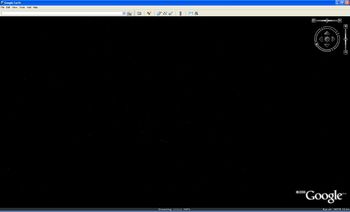
Click to enlarge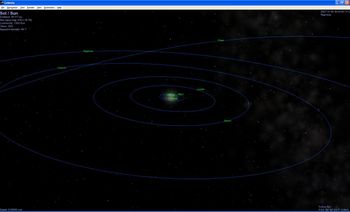
Click to enlarge
Terraforming cyberspace
Posted on Friday, December 29, 2006
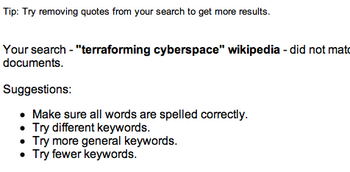
What, such a nice term with no wikipedia entry: terraforming cyberspace ? Isn't that what is going on inside Google Earth, Microsoft Virtual Earth and Second Life? Or is it 'terraforming Earth for the agents' (e.g using the DARPA Agent Markup Language)?. Following this line of thought, I stumble upon an interesting Google Earth overlay displaying the global status of the Grid via this press release: Grid computing 'Mappa Mundi' unveiled in Florida
Visitors to Supercomputing '06 in Tampa, Florida this week will be the first to see a new interactive map that shows nine of the world's largest computing Grids. The map, developed by researchers from GridPP in the UK and the European particle physics laboratory, CERN, in Geneva, uses Google Earth to pinpoint Grid sites on six continents, showing more than 300 sites overall. Like the medieval 'mappa mundi', which showed what was known of the world at the time, this is one of the first attempts to show the whole scientific Grid world.More via physorg.com. And from the article on 'terraforming cyberspace':
Tomorrow’s world will be filled with agents embedded everywhere in the places and things around us. Providing a pervasive web of sensors and effectors, these agents will function as cognitive prostheses— computational systems that leverage and extend human intellectual, perceptual, and collaborative capacities, just as a steam shovel is a sort of muscular prosthesis or eyeglasses are a sort of visual prosthesis. Thus, the focus of AI research is destined to shift from artificial intelligence to augmented intelligence.
Now in order for the agents to offer augmented intelligence, they will first of all need to know the location and all that surrounds it...GPS gives it location...virtual globes its situational awareness...
nice combo...
Posted on Friday, December 29, 2006
NASA's vision lost on Web generation (28 Dec. 06) v.v. Google teams up with NASA (18 Dec. 06)
And following up on Stefan Geens final bullet in his latest post, i'd say: it looks like Microsoft will win over Google, unless there is a way to make me build my own house (or anybody's else's...think: advertisement) in Google Earth...(or...what happens if Google buys Second Life)
Outer space in Second Lie Life
Posted on Sunday, December 24, 2006
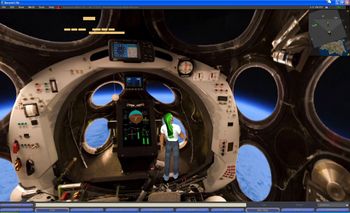
Click to enlarge
With the holidays and all, I had some time to spent looking for the International Space Museum (ISM) in Second Life. After having to complete the first test level (grrr), taking me more than an hour, I finally was allowed on the real playing field. Turned out the testing in the beginning was actually quite handy, cause I knew immediately how to get to the ISM as fast as possible...just type it in and search...boom....teleported and dazzled, I was throw out into the ISM piece of land...
btw, how you like my green hair? ;-) 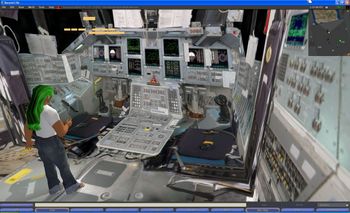
Click to enlarge
Welcome to the real world
Posted on Sunday, December 24, 2006
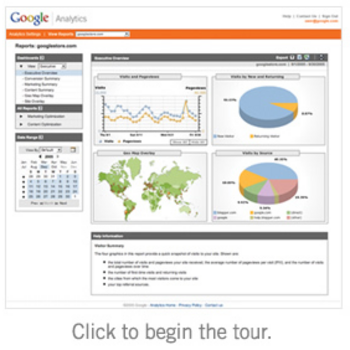
Being relatively new to the blogging game, I am stupéfait about the sophistication of the Google ad machine...take the red pill and have a look at this introduction about Google Analytics. If you ever wondered about monetization of the database of intentions...
Natural bridge on Mars
Posted on Saturday, December 23, 2006
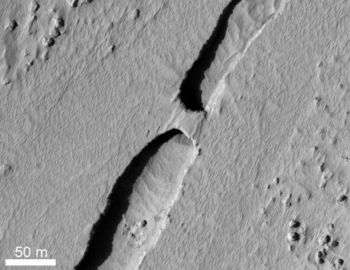
MRO continues to inspire (via Beyond the Beyond).
Gibraltar airport....
Posted on Friday, December 22, 2006
Wow, that's some ![]() runway to take off from...well, luckily(?) its not like that on the real planet Earth as the image below shows. Could be a nice landart hack though, taking this one a couple of steps further.
runway to take off from...well, luckily(?) its not like that on the real planet Earth as the image below shows. Could be a nice landart hack though, taking this one a couple of steps further.
Zooming out in Google Earth
Posted on Saturday, December 16, 2006
' 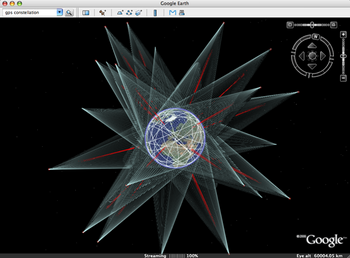
How long before Google Earth levels (and surpasses?) STK, the arcGIS of space...?
Above image is a screendump of one of the ![]() beautiful layers provided by Google Earth Community (GEC) member Paul Seabury (via Google Earth Blog). This
beautiful layers provided by Google Earth Community (GEC) member Paul Seabury (via Google Earth Blog). This ![]() particular one shows the GPS constellation in orbit around the Earth, together with a footprint of each individual satellite. Which reminds me of an earlier mash-up thought experiment I did by superimposing a Google Earth screendump with an image of the NASA J-Track 3D Java applet (see below). To get a feel of what that could be like, see instructions on the J-Track 3D opening page, click individual satellites to highlight their orbits, and drag the viewpoint around. Its a very light application and the combination of zooming and tilting the scene really 'gives handles' to the Geostationary orbit.
particular one shows the GPS constellation in orbit around the Earth, together with a footprint of each individual satellite. Which reminds me of an earlier mash-up thought experiment I did by superimposing a Google Earth screendump with an image of the NASA J-Track 3D Java applet (see below). To get a feel of what that could be like, see instructions on the J-Track 3D opening page, click individual satellites to highlight their orbits, and drag the viewpoint around. Its a very light application and the combination of zooming and tilting the scene really 'gives handles' to the Geostationary orbit.
Its a limitation of Google Earth I regularly run into: the limitation in the ability to zoom out. Currently, the furthest one can zoom out is to 'eye altitude 62355.98 km' (how does that work again?), not even enough to view the complete Geostationary ring, as is apparent in below image of ![]() Paul's Geostationary satellites layer (note zoom level of the two images is nearly identical).
Paul's Geostationary satellites layer (note zoom level of the two images is nearly identical).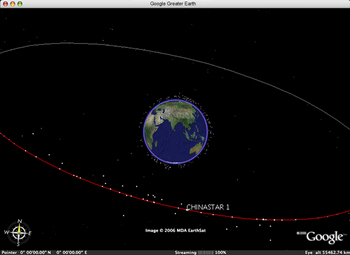
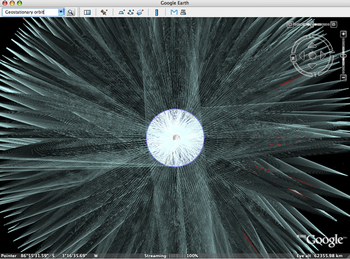
Arpanet of the future
Posted on Saturday, December 16, 2006
Here is a video I posted before about the early days of the Internet (Arpanet). Watching it again, its funny to see how the original ideas apply to the upcoming web as discussed in this Web2.0 Summit videocast between Eric Schmidt and John Battelle.
Stormy space weather ahead
Posted on Thursday, December 14, 2006
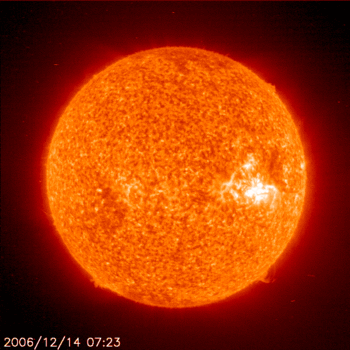
Update 18-12-06: Solar storm disrupts satellites
(via NASA Watch)
Opportunity has left the rim...
Posted on Wednesday, December 13, 2006
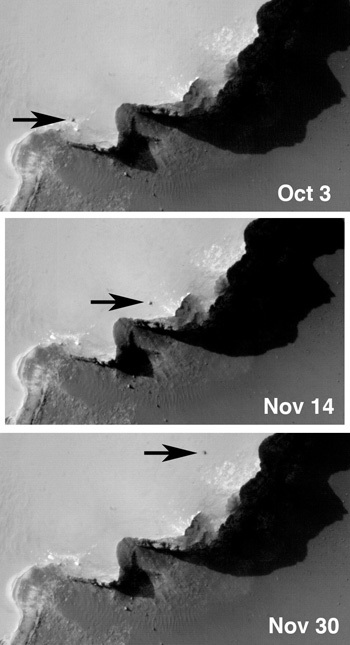
The Mars Reconnaissance Orbiter (MRO) keeps an eye out on the Mars Exploration Rovers as they scout the red planet. It has also found the landing sites of the two 1976 Viking Landers (more at NASA).
Virtual space exploration update
Posted on Saturday, December 2, 2006
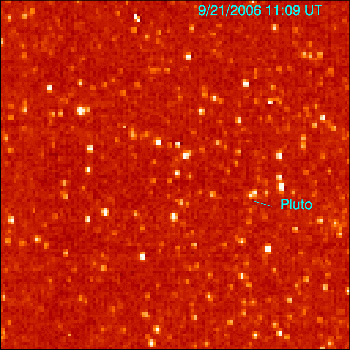
Seen at a distance of 4.2 billion kilometers, NASA's New Horizons mission captured a glimpse of its final target Pluto late September. Last week, NASA's Mars Reconnaissance Orbiter (MRO) mission located the landing site of the Mars Exploration Rover Opportunity (via Nasa Watch). By now, MRO's HiRISE team is flooding Mars images over the Internet.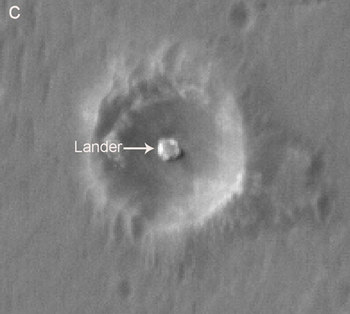
NASA moves into virtual worlds
Posted on Thursday, November 23, 2006

NASA is planning on building a virtual world for training and educational purposes. Its slashdotted here, which made it go around the world, like here at HighEarthOrbit, SlashGeo, Second Life News Network (SLNN) and KnowproSE. Daniel Laughlin, a project manager at NASA's Learning Technologies Office recently gave a presentation about it at the International Spaceflight Museum in Second Life (via OgleEarth). Here are some flickr images of the Museum.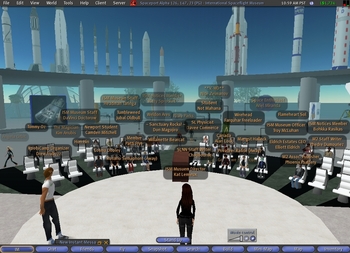
Satellites, humans, and the Internet of Things
Posted on Monday, November 20, 2006
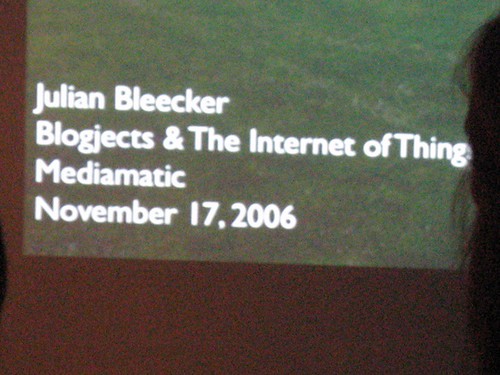
Julian Bleecker was here in Amsterdam for the RFID workshop at Mediamatic. Friday evening he gave a public talk on 'blogjects & the Internet of Things'. Made me think: what are satellites other than blogjects? (more on blogjects at Julian's techkwondo) And what about humans as presented here at Neven Vision? 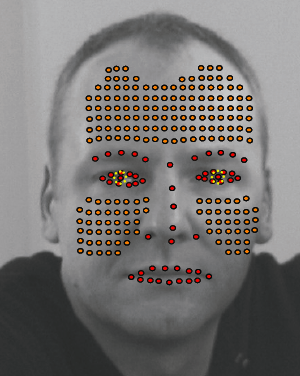
'...scroll over him with your mouse cursors...and...right-click!!'...Indeed, a good point by Julian: what do we learn that is useful from WoW 1008?
'realtime view of the Earth' widget?
Posted on Sunday, November 19, 2006
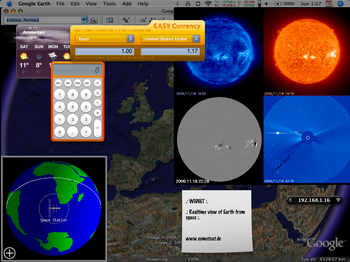
Just in: a demo video of Microsoft Virtual Earth 3D (which comes out blank on my macintosh btw) (via OgleEarth). Where do you want to go today? What about here:
(more at the SOHO website)
YES2 Google Earth
Posted on Thursday, November 16, 2006
Here is another one of my older posts (May '06) which I managed to bring back from digital oblivion by specifically interrogating The Google about my domain name and looking at the cached pages (search string 'site:tobedetermined xxxx'). Its only good for text though, cause other stuff like images is not cached (thanks for the tip Jurryt).
Recovered post:
Following up on my suggestion about the resemblance between the 3D GoogleEarth implementation of the TWA flight-800 disaster and the 2.5D visualisation currently available in YES2's Re-Entry Simulator Tool (REST), Marco Stelzer of the YES2 team at ESTEC has done a great(!) job implementing a REST2GoogleEarth output file option in REST.
The REST simulator, which is part of the larger YES2 mission simulator YESSim, is currently under development for ESA's 2nd Young Engineers' Satellite in order to study and control the landing of the YES2 'Fotino' re-entry capsule. The educational YES2 mission is designed to return a small capsule from space to the Earth using a 30 km long tether. Its launch is currently sheduled for October next year from the Russian launch base Baikonur onboard the Foton M3 spacecraft.
One of the REST2GoogleEarth output files developed by Marco provides an elegant display of the re-entry trajectory as calculated by REST, starting in this case from an initial altitude of ~253 km. Clicking on one of the dots brings up the longitude, latitude, and altitude of the capsule at that particular time in the re-entry (Directions: To here - From here ;) ). In this simulation, the time from start at 253 km to landing of the capsule in Kazachstan takes ~30 minutes. Its not so visible in this particular simulation, but I remember from an earlier one that the influence of the wind (through implemented wind models) on the final stage of descent comes out very nice in the GE visualisation.
In another section of the simulation tool, this 2nd REST2GoogleEarth output file shows the outcome of a monte-carlo simulation of the proposed landing site of the capsule, where each little dot represents a calculated landing point of the capsule. If you zoom out, you start seeing the landing ellipse of the Fotino capsule, representing the 3-sigma chance distribution of the actual landing position of Fotino.
For more on YES2, see their YES2 website (update: which is currently down I believe after having been hacked and them not having the time to bother with a website while building a satellite...). Once its back on, here is a short movie I shot & edited back in 2003 called YES2 meets...Michiel Kruijff with a brief introduction to the YESSim simulator.
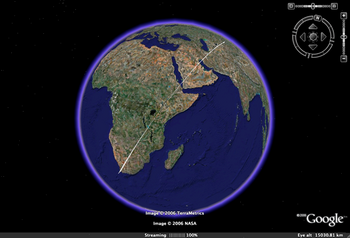
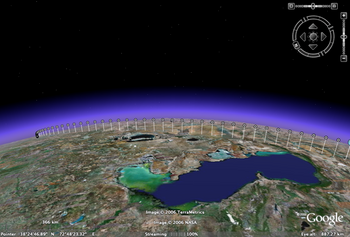
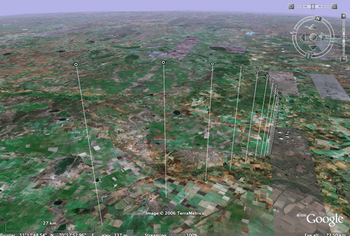
tobedetermined finds...a Google data center
Posted on Tuesday, November 14, 2006
I'll sometimes bring back an image/video which was in one of my earlier posts I lost when my blog (March-July 06) was accidentally erased from the server while over at the ISU Summer Session Programme 2006 in Strasbourg. This one is from an earlier article in the NY times.
Ministry of transport
Posted on Tuesday, November 14, 2006

Its not related to the theme of this blog, or maybe in the way it looks very second life while being actually first life, a ministry in our 'outer space'...The merger of outer space and the digital space might be a copernican revolution in the making. A flip in perspective, instead of a merger (what would that do to the relation between outer space and our daily lifes here on Earth?) (via we-make-money-not-art).
Another way things might go instead of merge, is the subject of this blog: The end of cyberspace (with the excellent slogan 'Goodbye virtual world. Hello new world')
Pale blue dot update
Posted on Sunday, November 12, 2006
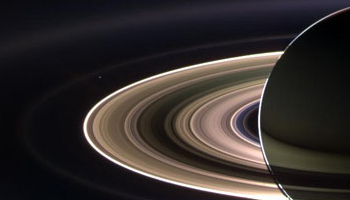
The little white pixel just above the rings of Saturn is...yep...the Earth. Here is the original Pale blue dot. More about this image at Saturn daily.
The future is process, not a destination
Bruce Sterling
Everything is ultimately becoming information technology
Ray Kurzweil
Data is the Intel inside
Tim O'Reilly
There is only one machine and the web is its OS
Kevin Kelly
The medium is the message
Marshall McLuhan





